Things To Know About Baglung District: The Hidden Jewel of Gandaki Province
- March 7, 2024
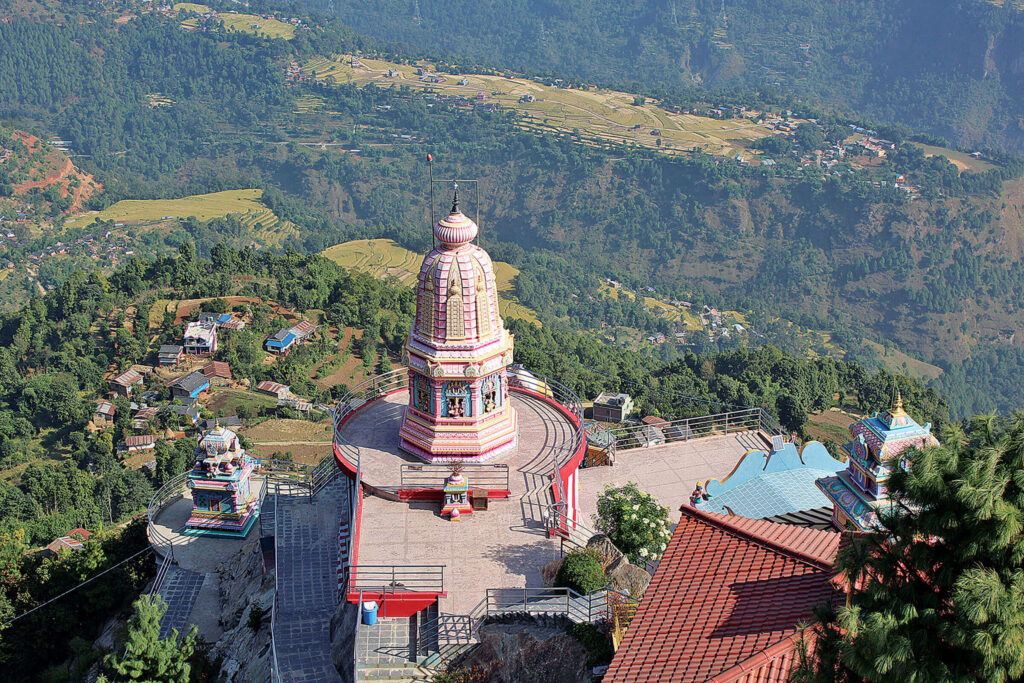
Baglung District in Nepal with a map that resembles the country’s shape, is a miniature of Nepal itself, with a diverse population, rich culture, and stunning scenery. Based on the shape, people often call it mini Nepal or small Nepal. It is a hilly district in the Gandaki Province of western Nepal. Naturally gifted Baglung is surrounded by other districts like Parvat, Rukum, Rolpa, Myagdi, Gulmi and Pyuthan. Headquartered by Baglung Bazar, Baglung district used to be the headquarters of the Dhaulagiri zone but was shifted to Pokhara when Nepal was reformed into a Provincial Government. As it has many rivers and suspension bridges, Baglung is also known as the district of suspension bridges.
Baglung is home to Nepal’s only hunting reserve – Dhorpatan Hunting Reserve. Popular herbs like Chiraito, Jatamasi, Yarsagumba, Satuwa, Padamchal, etc., are found in this district. Baglung is also famous for crops like rice, maize, potato, wheat, beans, soybeans, and fruits, including apples, oranges, bananas, guava, and so on.
Baglung District is a treasure trove of culture, history, and natural wonders. From its diverse geography to its rich history, Baglung witnesses Nepal’s multifaceted allure. Let’s dive into the hidden jewel of Gandaki Province.

Geography and Climate
Baglung boasts a diverse landscape. The district is characterized by undulating hills, lush valleys, and dense forests, making it a treat for nature enthusiasts. But what’s a visit to Nepal without its famed suspension bridges? Baglung houses some of Nepal’s most iconic suspension bridges , like the Gandaki Golden Bridge and the Chitre High Bridge.
If you’re wondering about the temperature of Baglung, it varies throughout the year. Baglung’s lowest altitude reaches temperatures of 37.5 degrees Celsius in summer , while its highest altitude, Dhorpatan, drops to -15 degrees Celsius in winter. The altitude of Baglung ranges from 650 meters at Kharbang to 4,300 meters at Dhorpatan.
Baglung District’s climate varies with altitude. It has warm summers and mild winters and is divided into five climatic zones: Upper Tropical, Subtropical, Temperate, Subalpine, and Alpine.
Baglung experiences its most delightful weather during the enchanting seasons of autumn and spring, providing an ideal time for a visit. March, April, October, and November are prime times when Baglung graces its visitors with mild and inviting weather conditions. Among these, April, May, June, July, and August are the warmest months, while January is the coldest month. As for precipitation, July is the rainiest month in this picturesque district.
Places of Interest to Visit
Baglung District is home to various places of interest, including religious temples, historical sites, and natural wonders. Here are a few of the most popular tourist attractions in Baglung District:
Panchkot Dham, Baglung
A serene spiritual haven, Panchkot Dham is a must-visit for those looking for a touch of calmness. Panchakot Dham, previously recognized mainly in Baglung, gained prominence after the inception of Panchakot Ekikrit Basti. Muktinath Baba claims it’s the exclusive location to discover the Shaligram stone. The name “Panchakot” stems from the fusion of five distinct “kots” (forts): Karikot, Raynaranynakot, Tatajalkot, Sansaarkot, and Majhkot.
A 30-minute bus journey from Baglung Bazaar can get you to this sacred site. The head of the temple, with the vision of developing Panchakot Dham into a unique pilgrimage site for all communities, is working to establish primordials for Adivasi, Janajati, and Aryan communities. This will make Panchakot Dham a religious destination for Hindus and people of all faiths. In addition to its religious and cultural significance, Panchakot Dham is a popular tourist destination for its breathtaking views of the surrounding mountains. Visitors can enjoy panoramic vistas of the Himalayas, including the Dhaulagiri and Annapurna ranges.
Baglung Bazaar
Baglung Bazaar, the oldest and most significant settlement in the Dhaulagiri Zone of Nepal, is a 45-minute drive from Nayapul, the heart of Baglung municipality. Despite its proximity to this popular tourist destination, Baglung Bazaar remains relatively undiscovered by foreign tourists due to its unplanned layout and lack of tourist infrastructure. The bazaar has grown organically, primarily serving locals and business travelers, with land values astonishingly matching those of Kathmandu.
However, Baglung Bazaar is still a popular destination for domestic tourists drawn to its rich culture and stunning natural scenery. The bazaar, situated on a plateau, overlooks the Kali Gandaki gorge and is flanked by the Dhaulagiri Himalayan range and cliffs, with the Kathe Khola, Kali Gandaki River, and Dhodeni Khola defining its boundaries.
One of the best ways to experience the culture of Baglung Bazaar is to visit the small village of Bhakunde, inhabited by the Magar community. Bhakunde offers homestays to visitors, providing them with a unique opportunity to learn about the Magar way of life. While Baglung Bazaar may be a minor tourist destination, it is a fascinating and rewarding place to visit. Its rich culture, stunning scenery, and affordable prices make it an ideal choice for travelers seeking an authentic Nepali experience.
Kalika Bhagawati Temple
Kalika Bhagwati Temple, a Hindu temple in Baglung, Nepal, is a mesmerizing attraction for its tranquil atmosphere. The temple is a popular pilgrimage site dedicated to the goddess Kalika, an incarnation of Durga, the Hindu goddess of power and strength. It is known for its detailed carvings and architecture.
The temple is about 6 kilometers from Baglung Bazaar, settled deep inside a dense forest on the banks of the Kali Gandaki River. Upon reaching the temple, visitors can feel a peaceful aura. The temple complex comprises a central temple, a courtyard, and several smaller shrines. Devotees gather in The temple courtyard to pray, sing hymns, and participate in religious rituals. There is also a dharmasala (pilgrim guesthouse) within the temple complex, which provides accommodation to devotees for a nominal fee.
The Kalika Temple is also known for its animal sacrifices. Many devotees believe sacrificing animals to the goddess Kalika will help their wishes come true. As a result, thousands of goats, buffaloes, ducks, and pigs are offered at the temple yearly during festivals like Navaratri and Dashain. Despite the animal sacrifices, the Kalika Temple remains a popular pilgrimage site for Hindus from Nepal and India. The temple’s serene atmosphere, detailed carvings and architecture, and cultural and religious significance continue to draw devotees of all ages.
Bhakunde is a small village in the Baglung district of Nepal, located about 10 kilometers from the city of Baglung. Bhakunde is home to the Magar community, one of Nepal’s many ethnic groups, and is known for its rich culture and stunning natural scenery. The village is on the hilltop overlooking the Kali Gandaki River gorge. The Dhaulagiri mountain range is visible in the distance, making for breathtaking views. Bhakunde is also home to several waterfalls and caves, popular tourist attractions.
The Magar community is one of the largest indigenous groups in Nepal. They are known for their unique culture and traditions. The Magar people of Bhakunde are particularly skilled in traditional crafts, such as weaving, basketry, and metalworking. Visitors to Bhakunde can experience the Magar way of life by staying in a homestay. Homestays offer visitors a chance to learn about Magar culture and traditions and to sample local cuisine. Bhakunde is also a popular destination for trekking and hiking. Many trails lead to nearby villages and mountain peaks. It is also a home for many organic Homestays.
Dhorpatan Hunting Reserve
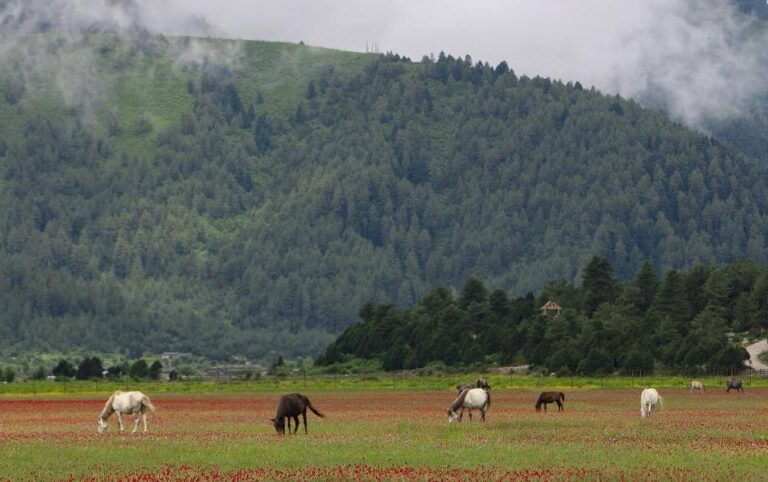
Dhorpatan Hunting Reserve, located amidst the Dhaulagiri Himal range in West Nepal, spans 1,325 sq. km and is the nation’s only hunting reserve. Established in 1983, the reserve’s altitudes range from 3,000m to over 7,000m, with higher elevations permanently snow-capped. These high altitudes house patans (flat meadows above 4,000m), vital for blue sheep and other herbivores. The area is segregated into six blocks for hunting management and is surrounded by villages, except to the north. Locals rely on it for timber, fuelwood, and pasture, and every year, over 80,000 livestock graze here from February to October. The reserve boasts a diverse ethnic population with a mix of cultures due to the amalgamation of various groups, primarily of the Mongoloid race.
The reserve’s plants are primarily alpine, sub-alpine, and high-temperate vegetation, with many fir, pine, birch, and rhododendron trees. Over half the reserve’s area at higher elevations is patan. It’s a primary habitat for 852 blue sheep, as recorded in a 2007 survey, and also houses leopards, Himalayan tahrs, barking deer, and 137 bird species. Among them, musk deer, red pandas, and Danphe are endangered species. The Department of National Parks and Wildlife Conservation manages hunting licenses. The region experiences monsoons until early October, particularly cold and windy winters. The best time to visit is March-April. Unique spots include Dhorbaraha, a Hindu religious site, and the breathtaking views of the Dhaulagiri Himal from Barse and Gustang blocks. Transportation options range from buses from Kathmandu to charter helicopters, though visitors are advised to carry fuel requirements.
Gandaki Golden Bridge
The Gandaki Golden Bridge is a renowned suspension footbridge stretching 567 meters over the Kaligandaki River in Nepal, connecting Kusma Municipality of Parbat district to Baglung Municipality in Baglung. Standing 122 meters above the river, this architectural marvel was the world’s longest footbridge until the unveiling of the Sky Bridge 721 in the Czech Republic in 2022. With a load-bearing capacity of 85 MT, it can accommodate 612 individuals simultaneously. The bridge, known as ‘Gandaki Sunaulo Jhula’ in Nepali, is a testament to engineering prowess. It has become a major attraction for local and international tourists due to its breathtaking views, especially during dawn and dusk.
Visitors can reach the bridge conveniently near Baglung Bazaar within 5-10 minutes. Its proximity to other notable landmarks, such as the revered Kalika Bhagawati temple, makes it a focal point for those exploring the region. The bridge serves as a functional linkage between districts and stands as a symbol of Nepal’s infrastructural development and its appeal as a travel destination.
Chitre High Bridge Trek
The Chitre High Bridge Trek in Nepal offers a unique and transformative experience, combining the tranquility of untouched nature with a glimpse into the authentic rural Nepalese lifestyle. This trek encloses the Chitre and Panchase Treks, ensuring an intimate encounter with the region’s breathtaking landscapes. Trekkers are treated to iconic views of the dazzling white peaks of Hiunchuli, Tukuche, Barha Shikhar, Lamjung Himal, and Dhaulagiri. The trek’s distinctive charm lies in its homestay opportunities, allowing travelers to immerse themselves in local culture and traditions.
In addition to the unparalleled mountainous scenery, participants can witness the day-to-day life of local people, fostering a deeper understanding and appreciation for the region’s customs and way of life. The trek is especially notable for its stunning morning views of the mountains from the view tower, offering a serene and scenic start to the day. The Chitre High Bridge Trek is ideal for those seeking a less crowded yet richly rewarding adventure in the heart of Nepal, blending natural beauty with cultural immersion.
Shreedharacharya Saligram Museum
The Shreedharacharya Shaligram Museum, an underground museum in Kundule, Baglung, is a unique institution dedicated to preserving the religiously significant ‘Shaligram’ (Ammonite Stone) symbolic of Lord Vishnu. Established during the Nepal tourism year 2020, the museum is situated within the Rangbaiketswar Muktinarayan Temple premises in Tirupati Balajidham. Built through crowdfunding, the museum spans a 76-meter-long tunnel and aims to highlight the rich Kaligandaki civilization. Visitors can reach the Shaligram Sanghralaya after a 10-minute bus ride from Baglung Bazar. The museum showcases a collection of around a million shaligrams and various artifacts and statues representing Hinduism, offering insights into the region’s history and cultural heritage.
The museum has been a significant attraction for domestic and Indian tourists exploring regions like Parbat, Myagdi, Baglung, and Muktinath. The museum had collected shaligrams for 14 years but vanished due to inadequate protection. The museum’s design, inspired by the trident – believed to be Lord Shiva’s favored weapon- comprises four sections within the 76-meter tunnel described by Swami Prapannacharya.
Baraha Taal
Baraha Taal is a scenic lake in the Bhakunde Village of Baglung district of Nepal. It is a popular tourist destination for its serene surroundings and lush green forests. The lake is 1,350 meters above sea level and covers an area of 2,826 square meters. It is a popular spot for picnicking, boating, and birdwatching, attracting many nature enthusiasts and adventure seekers. Baraha Taal is also a popular location for Hindu pilgrims, as it is believed to have religious significance and is considered sacred by some local communities.
In addition to its natural charm, Baraha Taal holds religious significance for local communities and Hindu pilgrims, adding a spiritual dimension to its appeal. The lake’s sacredness makes it a focal point for religious activities and pilgrimages. Conveniently accessible, Baraha Taal is just a 30-minute bike ride from the district headquarters, Baglung Bazar. It is popular for local and international tourists seeking spiritual fulfillment and natural beauty.

Gaja Daha, a serene travel destination 2,480 m above sea level in Jamini Municipality Ward Number 3, is an intersection point for Jaimini, Baglung, Galkot municipalities, and Bareng rural municipality. Positioned east of Jaimini, west of Galkot, north of Kathekhola, and south of Bareng, its allure stems from natural beauty and cultural and historical significance. Traditional houses spotting the area add a unique charm, and the locale is known for its pristine pond, where, as per locals, birds ensure no leaves float on the surface and its winter snowfall. Once known as Rudra Taal, Gaja Daha holds interest for both nature enthusiasts and history buffs.
For travelers seeking to explore Gaja Daha, the journey from Kathmandu is approximately 291 km, with the closest urban center being Baglung Bazaar, 24 km away. The area is accessible by foot or jeep; a walk offers an immersive experience and takes around four hours, while a jeep ride significantly shortens the travel time to approximately 1.5 hours. The route via Pokhara and Baglung offers scenic views and a glimpse into the region’s diverse landscapes. Whether on foot or by vehicle, visiting Gaja Daha promises a blend of natural splendor and cultural richness.
Munta Dada is a peaceful place where anyone can conveniently reached with just a 20-minute bus ride from Baglung Bazaar. With the lush green hills and expansive forests, it provides a tranquil escape from the hustle and bustle of urban life. This ideal spot is a favorite among picnickers and nature enthusiasts, drawing adventure seekers seeking relaxation in its natural beauty.
One of Munta Dada’s highlights is the panoramic view it offers. From this vantage point, you can behold the entire Baglung Bazaar, along with the longest suspension bridge and Kusma Bazaar. The view from the hilltop is nothing short of breathtaking, providing a sweeping perspective of the surrounding landscape. On clear days, the vista extends for miles, allowing you to appreciate the diverse terrains, including rolling hills, verdant forests, flowing rivers, bustling cities, and majestic bridges. Even on hazy or cloudy days, Munta Dada offers a unique and peaceful experience, connecting you with the beauty of the natural world.
How Can You Reach Baglung?
Baglung District is well-connected to other parts of Nepal by road and air. You can have a couple of convenient options:
- By Road: Baglung is well connected by road. Regular bus services ply from major cities like Pokhara and Kathmandu. The bus journey from Kathmandu to Baglung takes approximately 7-8 hours, and the bus journey from Pokhara to Baglung takes around 3-4 hours.
- By Air: Baglung is served by a domestic airport named Baglung Airport, also known as Balewa Airport. Travelers who prefer air travel can book flights to this airport for a faster and more convenient journey from major cities.
- Trekking: Baglung offers excellent opportunities for trekking enthusiasts. The region boasts scenic trails and natural beauty, making it an ideal destination for trekking adventures. Trekkers can explore the stunning landscapes and cultural heritage of Baglung, providing a unique and immersive travel experience.
- Travel Agency: You can also book your travel to Baglung through a travel agency. Travel agencies can arrange transportation, accommodation, and activities and provide advice and support.
Accommodation Options in Baglung
If you plan a trip to Baglung, you must find a place to stay. Many hotels and local guesthouses in Baglung offer various food & lodging services, but knowing which ones are the best can take time and effort. Finding suitable accommodation is crucial for a comfortable and enjoyable stay. Fortunately, Baglung offers a range of options to suit various preferences and budgets. One highly recommended platform for booking hotels in Baglung is Holiday Pasal.
Why Book Your Accommodation Through Holiday Pasal?
Holiday Pasal is a leading travel and tourism company in Nepal. They have many hotel and accommodation options in Baglung and other parts of Nepal. Holiday Pasal offers competitive rates and excellent customer service. You can book your hotel through their website or contact them directly. To contact Holiday Pasal , you can call +977-9851134714.
Baglung District is a hidden treasure waiting to be discovered. From its awe-inspiring landscapes to its rich cultural heritage, Baglung has something for every traveler. From its iconic suspension bridges in Nepal to its bustling Baglung Bazaar , from its spiritual sites like Panchkot Dham to natural wonders like Gaja Daha , Baglung District is a microcosm of all Nepal offers. As we’ve seen, there’s no shortage of reasons to explore this gem of Gandaki Province. So why wait? Pack your bags, book your tickets, embark on this incredible journey to Baglung, and create memories that will last a lifetime!
FAQs About Baglung District
Baglung District is located in the Gandaki Province of Nepal.
It’s renowned for its historical sites, religious significance, and iconic suspension bridges. Last but not least, the sole hunting reserve of Nepal, Dhorpatan Hunting Reserve.
Here are some of the things you can do in Baglung District:
- Visit Baglung Bazaar.
- Explore Baglung Kalika Temple.
- Hike to Dhaulagiri Viewpoint.
- Cross the Gandaki Golden Bridge.
- Go on hunting in the Dhorpatan Hunting Reserve.
- Visit the Bhakunde village to experience the traditional Magar culture.
Depending on your preference, you can opt for hotels, guesthouses, or even camping.
Baglung experiences its most delightful weather during the enchanting seasons of autumn and spring, providing an ideal time for a visit.
Yes, there’s a range of accommodation options, from luxury hotels to cozy homestays.
Related Posts
advertisement
Subscribe to our Newsletter
Never miss out exciting offer

Book by phone
+977 9851134714
- Travel Pasal Network
- Educational Tour
- Property Registration
- Privacy Policy
- Terms & Conditions
- Flight Policy
- Hotel Policy
- Packages Policy
- Activities Policy

Payment Partners

© 2024 Holiday Pasal. All Rights Reserved
- Tour Packages
- baglung-district-gandaki-province

Baglung District - District in Gandaki Province
Baglung District is one of Nepal's seventy-seven districts and is located in Gandaki Province. The district, which has Baglung as its district headquarters, has a population of 268,613 people and occupies an area of 1,784 km2 (689 sq mi).
Today we talk about different aspects of Baglung.
Introduction to Baglung District
Baglung is surrounded by the districts of Myagdi, Parbat, Pyuthan, Rukum, Rolpa, and Gulmi. There are 59 Village Development Committees and a Municipality in the region. Baglung is better known as the "District of Suspension Bridges" because of its many suspension bridges. It is a hilly district with the majority of the people living along the rivers' banks.

Baglung Panchakot: Historic Majesty Captured
Credit: Imagepasal.com
The fertile soil on both sides of the rivers were used for agriculture. Baglung Municipality, the district's headquarters, is situated on a hill overlooking the sacred Kali Gandaki. Baglung, like Nepal, is diverse in terms of religion, history, race, altitude, and temperature.
Herbal medicinal plants abound in Baglung. Baglung's principal crops are rice, corn, millet, wheat, and potato. In the past, small-scale mining, mainly for iron and copper, was a significant operation in Baglung. However, owing to the economics of running small mines, the majority of them have since closed.
In modern times, slate mining is the most common form of mining. Baglung slate is thought to be outstanding for roofing.
Baglung's primary trade centres are Baglung Municipality, Hatiya- Galkot, and Burtibang. Roads bind Kusma, Galt, and Burtibang to Baglung Bazaar, the district headquarters. Nepal Electricity Authority and a number of small local hydropower plants serve Baglung.
Telephone service has recently been made available in nearly all Baglung villages. Baglung is one of Nepal's most politically aware districts, and it plays an integral part in the country's politics.
How Can You Reach Baglung?
Baglung is now at the crossroads of Nepal's main north-south and east-west highway networks, thanks to the completion of many road projects. The Kaligandaki corridor highway, which connects Tibet to the north via Mustang and border towns to the south, has begun construction.
Similarly, the city is bisected by the mid-hill highway that divides Nepal's eastern and western halves. Baglung is connected to Kushmi Sera in the south by the Hari Bahadur Khadka memorial road, which also provides access to Balewa airport.
Baglung is linked to Myagdi's Beni Bazar to the north and Parbat's Kusma Bazar to the south, which are 13 km (8.1 mi) and 12 km (7.5 mi) apart, respectively. The Pokhara Baglung highway links the town to Pokhara, which is 72 kilometres (45 miles) east.
Baglung Bazar is the starting point for another significant road network linking Gulmi district in the south, which passes through Sigana, Gaja, and Bareng.
A road network connecting Baglung Bazar and Bihu, which passes through settlements higher in the northern flanks of the Kathe Khola valley, was recently completed under the initiative of the late member of parliament, Hari Bahadur Khadka. Aside from major highways, the town is connected to the surrounding rural areas by a network of small seasonal dirt roads.
There are several pedestrian suspension bridges in the city. Baglung is known as the "country of suspension bridges" because of the abundance of them. Pharse, Nirahe, Nayapul, and Kaiya are all important Kaligandaki river crossings.

Baglung Bridge: Crossing Boundaries Gracefully
Credit:Nepaltraveller.com
The Kaligandaki bridge connecting Kaiya and Kushma is noteworthy for having Nepal's most prominent and longest span. The Kaligandaki River is crossed by a mechanical cable car that connects Narayansthan and Kushma. Within the city limits, several other suspension bridges connect numerous rivers and creeks.
Balewa's Baglung airport is 12 kilometres south of the town, across the valley from Kusma. This airport has been decommissioned after the Pokhara-Baglung highway was completed. Water transportation is almost non-existent.
The nearby Kali Gandaki river, on the other hand, provides some of Nepal's best white-water rafting and draws a sizable number of thrill-seekers each year.
Climate of Baglung District
In summer, the lowest temperature at Dhorpatan is around 15 degrees Celsius, while the highest temperature at Baglung's lowest elevation is about 37.5 degrees Celsius. Baglung is divided into five climatic zones. They are:
- Upper Tropical
- Subtropical
Effect of 2015's Earthquake on Baglung District
An earthquake in Nepal in April 2015 had a minor impact on the district. Many historic structures were damaged, and a few even collapsed. Many of the designs have since been restored by the owners.
Places to Visit in Baglung District
From Baglung, you can see the Himalayas. The Dhaulagiri and Annapurna ranges can be seen from Bhakunde and Panchakot. The region is rich in terraced lands, waterfalls, deep gorges, woodland, and caves. Baglung is a popular destination for thrill-seekers due to the terrain's suitability for trekking, biking, and rafting.
In the past, Baglung acted as a starting point for trekkers heading to Mustang, Dolpa, and Mt. Dhaulagiri. Baglung now serves mainly as a staging point for travellers to these areas as a result of the extension of road networks. The district includes the Dhorpatan Hunting Reserve, Nepal's only hunting reserve and a sanctuary for blue sheep and snow leopard.

Baglung Valley: Nature's Tranquil Elegance
Credit:Nepaltrekking.com
Baglung has resurfaced on tourist maps thanks to a recent increase in interest in the hunting reserve, Putha Himalaya range, round Dhaulagiri trekking, and "Guerrilla trek."
There are many tall suspension bridges in the city. Nepal's most elevated, one of them connects Balewa within the city's southern limits with Kushma across the Kaligandaki River. Tityang is connected to the city centre by a second, shorter bridge that crosses the Kathekhola canal.
Pilgrimage places abound in and near Baglung's temples. The Kaliaka Bhagawati Temple, the most famous of all religious sites in Baglung, attracts thousands of pilgrims each year. During the Chaitra Dashain festival, an annual fair, one of Nepal's most significant, is held.

Panchakot: Historic Fortress Beauty
Credit:myrepublica.com
Panchakot is being established as a pilgrimage and religious education centre under the patronage of Shree Muktinath Baba Kamalnayanacharya. On Tuesdays, devotees flock to Balewa Bhairavsthan, an ancient temple situated atop a mountain ridge.
Temple of Balaji Other pilgrimage sites include Kundule, Niraheghat, Gaurighat, Malika, Khaniyaghat, and Maikuti.
Prepare For Your Trip
Ask for advice.
Exchange tips with travellers on our List & Go forum
Book A Flight
Find the best fares and last-minute deals
Book A Hotel
Rest your weary head between adventures
Book A Travel
Buy comprehensive cover for your next trip
Book A Homestay
Book now and pay when you arrive at the property
- Health & Wellness
- Personal FInance
- Home Improvement
- Tourism & Places
- Tools & Equipments

Table of Contents
✓ Baglung is a Municipality in Gandaki Province that lies in Western Nepal which is 275 km far away from Kathmandu. It is the headquarters of the Baglung District which covers an area of 1,784 square kilometers, According to the census 2021 it has a population of 250,554, and it is also a part of the Dhawalagiri Zone .
✓ It is rich in nature & culture and is also known as Beni Bazaar. It is located at the cross-section of the Kaligandaki corridor that transverses Nepal in Northern–Southern & mid-hill highway that transverses Nepal in Eastern–Western directions respectively. It is covered by several districts like Parbat, Myagdi, Rukum, Rolpa, Gulmi, and Pyuthan Districts. It is a getaway to Mustang and Dhaulagiri mountain peaks, & Mustang.
✓ It provides major service centers: Business, Finance, Education, Healthcare & also other many services. It is a hilly region many people live on the sides of the river. For farming purposes fertile planes are on both sides of the river. There are many foot traffic are abundant also known as suspension bridges. Many other suspension bridges also can be found in rivers and rivulets within the city limit.
✓ It is divided into many cultures, religions, casts, ethnicity, altitude, temperature, & many others.
✓ It is rich in herbal medicine plants which are generally found in hilly regions. The major crops of Baglung are Rice, corn , millet , wheat , & potato . There are many mines located in Baglung: iron and Copper mines being the most prevalent.
History
✓ In 1534 AD year, King Pratap Narayan ( Later Galkot ) of Parbat married the daughter of King Manimukunda Sen of Palpa. King Pratap Narayan brought Kalias a dowry that is not able to carry by anybody. A youth who is from the Kunwar family was able to carry the sword of Kali and was given the title of Khadka ( sword ).

✓ One night, The king had a dream that Kali liked the place and wished to stay therefore the king decided to build the temple. Till 1590 BS ( 1533 AD ) this date, the Significants of the Population of Khadka Chhetri had been found. And King Pratap Narayan started the tradition of an annual fair during ‘Chaitra Dashain’. In the 18th century, Newar people moved to Baglung from Bhaktapur district. Baglung is a Great part of Nepal Greater Nepal under the war which was led by King Prithvi Narayan Shah.
✓ After the war, several government offices have established so it was named as the headquarters of the Baglung District and also named an important economic & political town in Dhaulagiri Zone.
Demographics
✓ According to the 2021 census, there are 250,554 inhabitants in Baglung as per the report of the state restructuring committee. According to the 2021 census, annual Population growth decreased by −0.69%. People of Baglung do not speak only Nepali they speak many languages such as Newari, Gurung, Thakali, Tibetan, and Magar.
✓ Baglung is a multicultural community that connects to the cultural city of Bhaktapur. It is divided into many cultures, religions, casts, ethnicity, altitude, temperature, & many others.

Best place to travel in Baglung
1. chitre high bridge trek .

✓ This is a fantastic trek in Nepal with beautiful views of the Himalayas.
✓ This is an adventure that includes Chitre Trek and Panchase Trek.
✓ It combines nature, culture, & tradition of Nepalese people.
2. Panchakot Dham

✓ It is turned into the tourist destination of Baglung, a Hindu sage, the influx of tourists has increased in this area after the complete construction, under the leadership of Muktinath Baba.
✓ This place is related to the ancient kings which is established to worship divine energy and to get power from it.
✓ This Dham is made by five different kot: Karikot, Raynaranynakot, Tatajalkot, Sansaarkot, and Majhkot.
3. Shiva Dhuri Village

✓ It is located in the Bihunkot, Baglung & also effective as the provincial government is focusing on homestay tourism in recent times.
✓ All set is provided in this village, to welcome national as well as international tourists which is a Homestay facility to flow the tourist.
✓ This village is famous for Rhododendrons and for its view of the Annapurna Himalayas.
4. Balewa Bhairavsthan

✓ This temple is dedicated to the have been ruled Bhuretakure kings.
✓ Northern western of Bhairabsthan temple is Bhakunde town which has its significance in magar culture & the traditional food & accommodation in homestays.
✓ It is enlisted in the top 100 tourism destination areas in Nepal.
Transportation
The completion of many highways project has put Baglung at the crossroads of the major Northern–Southern, and Eastern–Western highway systems of Nepal. Traks are opened for the Kaligandaki Corridor highway to connect Tibet to the north via Mustang and border towns in the South. Hari bahadur khadka monument road connects Baglung with Kushmi Sera in the southern city. It is also connected to the Beni Bazaar at the Magydi to the Northern part.
Economy
There is a large number of government and non-governmental institutes & Administrative as well as service centers located. It is a banking and financial center of the Kaligandaki Valley region. Financial services are also provided by several co-operatives and finance companies which is operated out of the city. Remittance plays an essential role in the economy of Baglung. In the neighboring Country of India, a huge number of people are employed. The transportation sector is also the main source of employment in Baglung.
The town is fulfilled with many grocery stores, repair shops, tailors, beauty parlors, & clothing & electronics outlets also a few small-scale industries. A significant number of people are employed in schools and institutions of higher educational level.
Culture
Baglung is a multicultural city also known for its folk Nepali music. On the occasion of ‘Chaitra Dashain’, a Folk music competition is also held there. Dance-Lakhe, Maruni, Ghatu, Hanuman, Jogi, Ropai, Katuwal, Putali, Sisno, Khesnae, Bagh, Mayur (peacock), Jhakri, Adi, Sorathi, Salejo, Kheli, Thado Bhaka.

What are Yomovies?: How to Use it and Features and More – Multiple Best Hollywood and Bollywood Movies in Online
What is mp4moviez – full review of guide with alternatives to use in 2024, what is hdhub4u – is it safe and legal: a review of guide, how to do a bold lip: top 5+ tips.
- Terms and Policy
©Theleopost.com 2023

- December 9, 2019
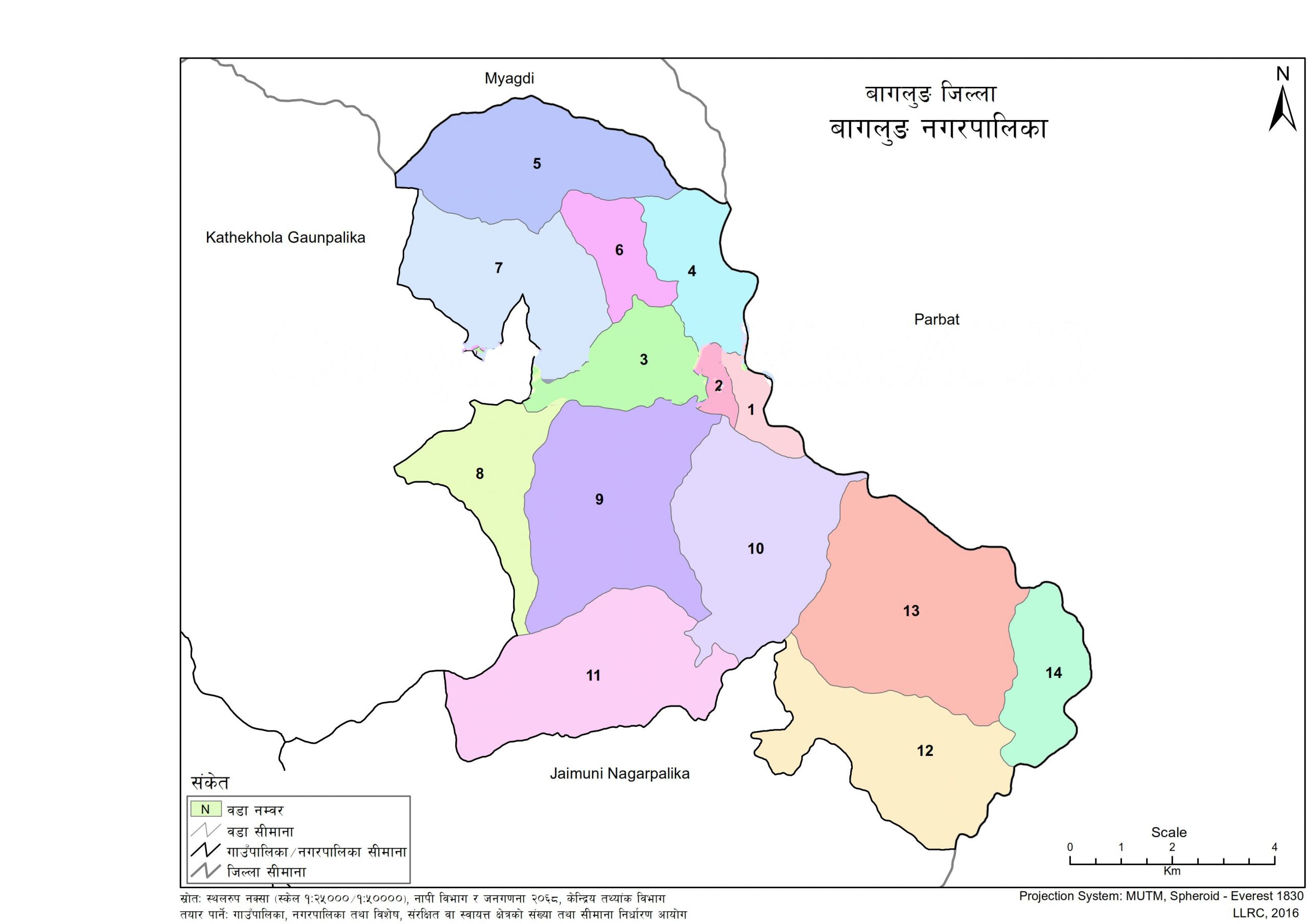
View Full Map
Wardwise Population and Households
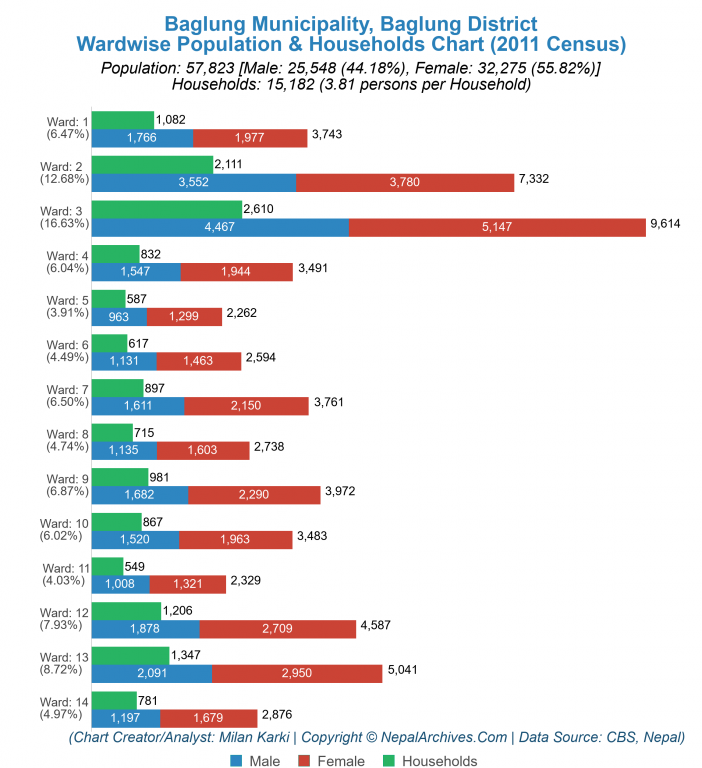
View Full Chart
As illustrated in the chart, the ratio of male to female population was 0.79, which indicates that Baglung Municipality had 21 percent lower males as compared to the females. Same as, the population to household ratio was 3.81, which means that in average 3.81 family members lived in each household.
Absentee Population
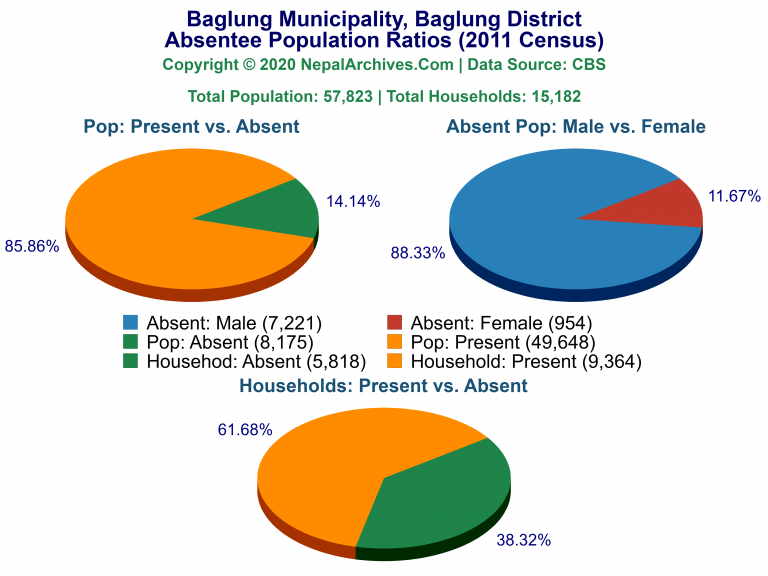
Population by Age Group
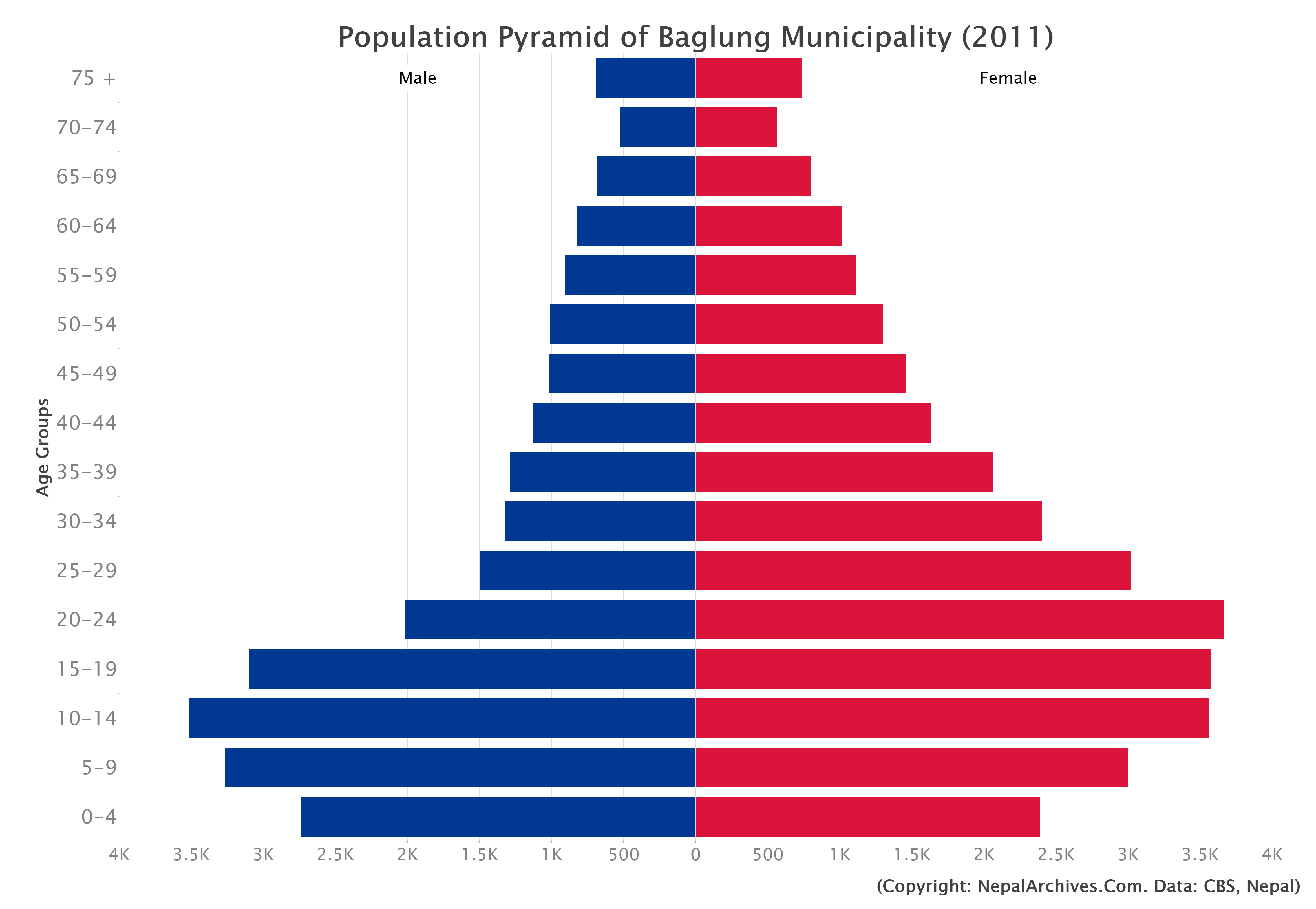
Population Ratios
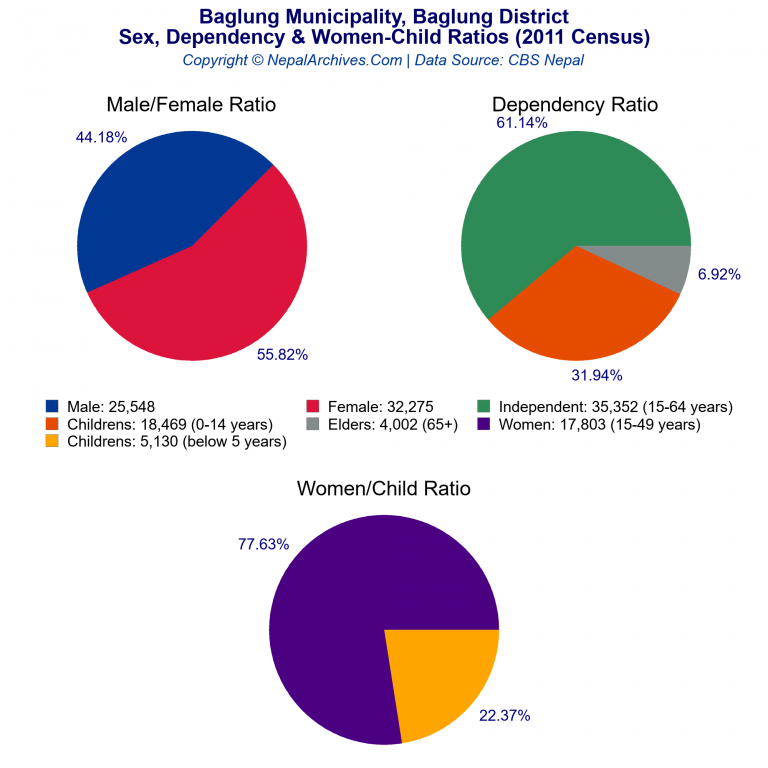
Literacy, Education Levels & Schooling
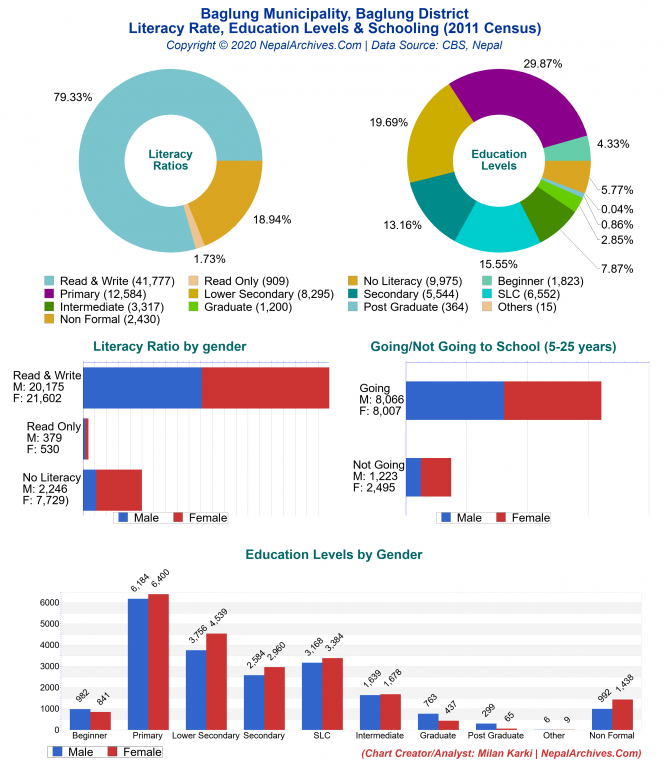
Grade 1-12 Students & Schools
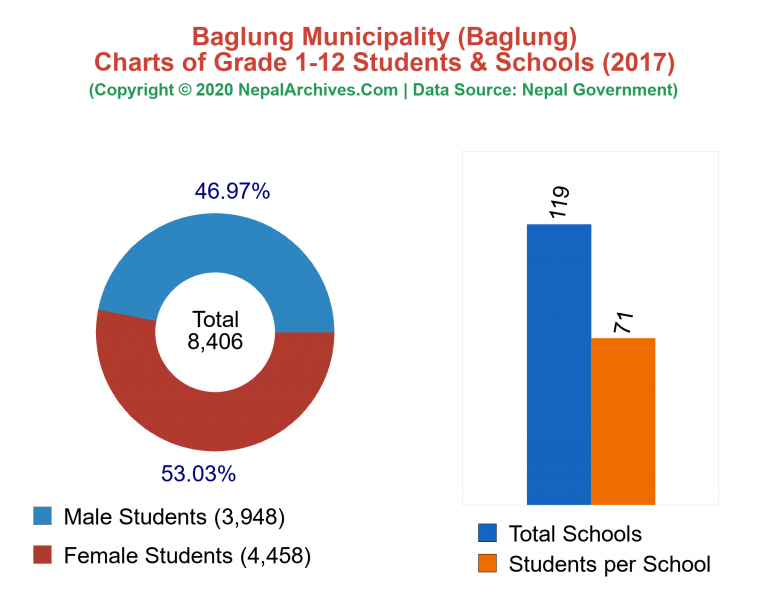
Population by Language Spoken
Mostly spoken language in Baglung is Nepali, which is spoken by 54,112 people. The Baglung has people who speak other languages, such as Magar, Newar, Bhojpuri, Chhantyal, Tamang, Hindi, Gurung, Maithili, Tharu, Rai, Thakali, etc.
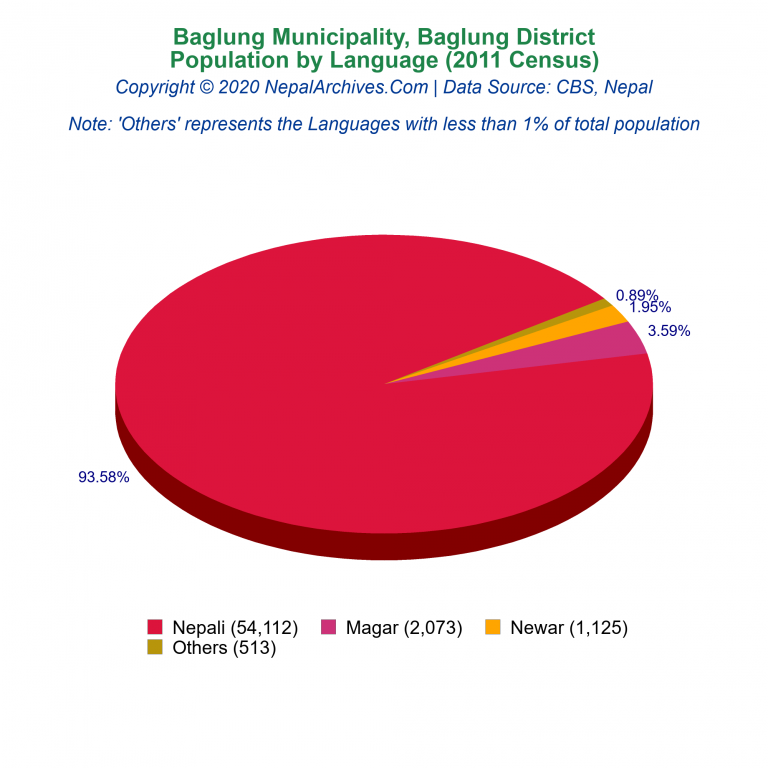
Population by Castes
According to 2011 census conducted by Central Bureau of Statistics (CBS), Baglung Municipality was inhabitted by mostly the people of Brahmin - Hill caste with total population of 18,279. There were as little as Sunuwar caste with population of as little as 12 in total. People of several other castes who live in Baglung are Chhetri, Magar, Sarki, Kami, Damai/Dholi, Newar, Thakuri, Muslim, Chhantyal/Chhantel, Tamang, Majhi, Gurung, Thakali, Dalit Others, Gaine, Sanyasi/Dashnami, Rai, Tharu, Kumal, Teli, Sonar, Terai Others, Yadav, Haluwai, Kathbaniyan, Gharti/Bhujel, Hajam/Thakur, Brahmin - Tarai, Sunuwar, etc. Only the population of castes with above 1,000 population are illustrated in the table.
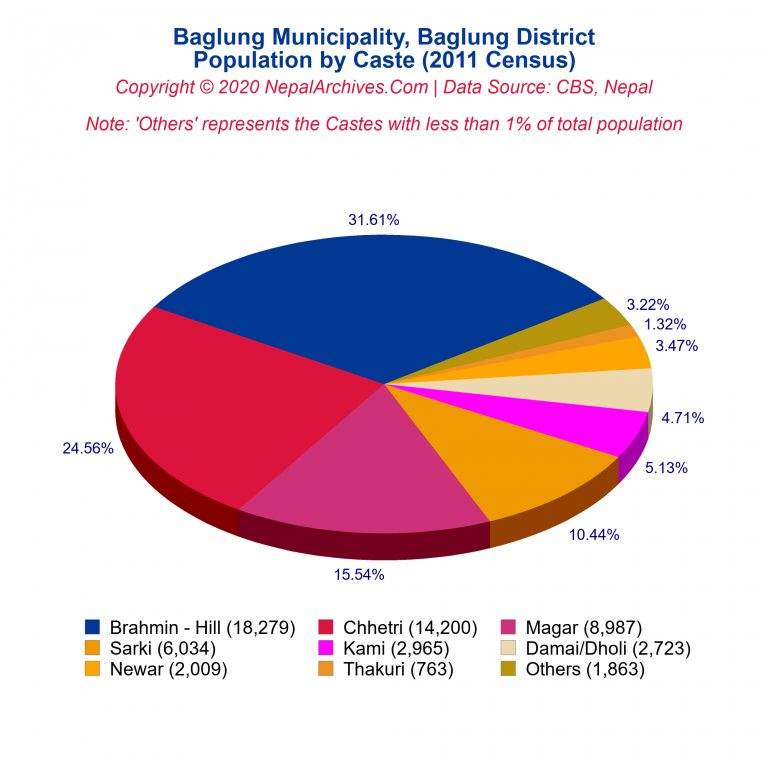
Population by Disability
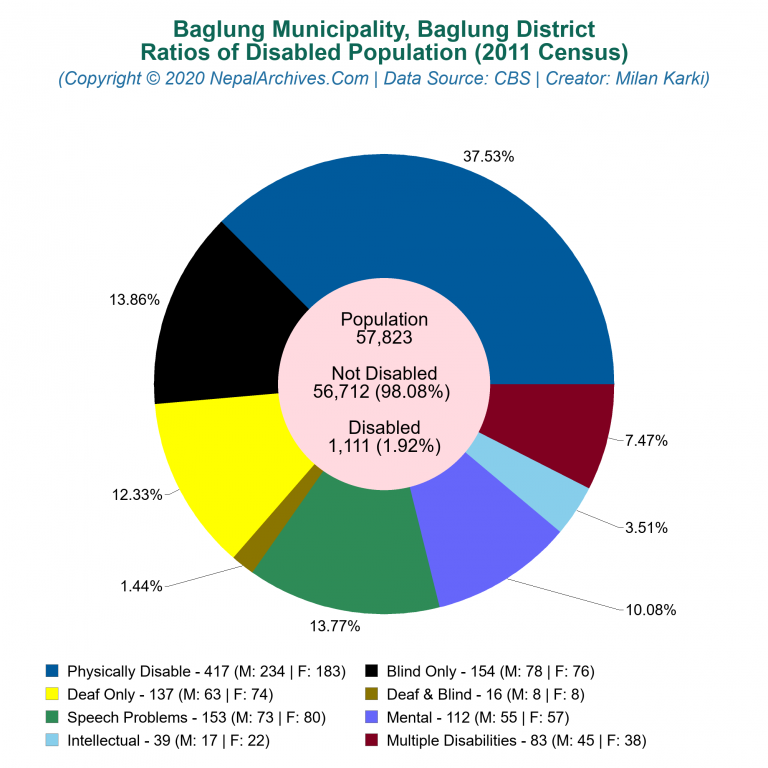
Household Foundation
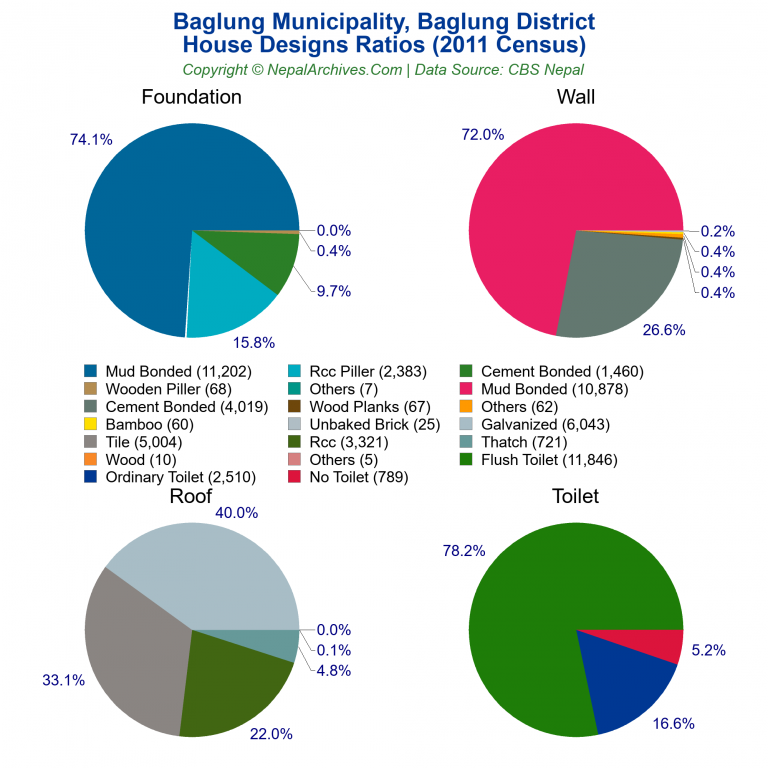

Economic Census
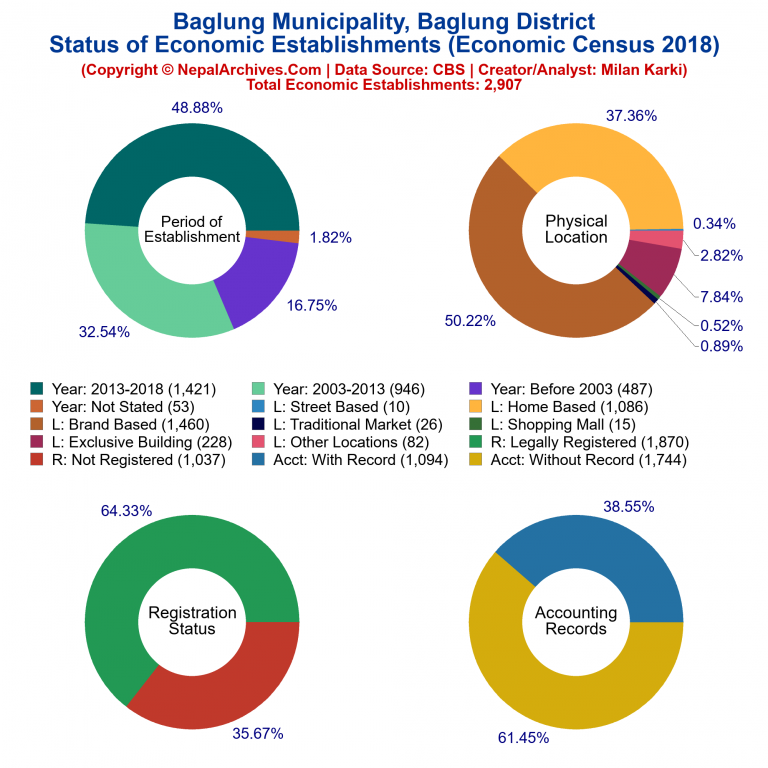
(Desclaimer: The statistical data published about Baglung Municipality profile in this page are exclusively obtained from Nepal Government's Central Bureau of Statistics (CBS) as well as other verifiable Nepal Government sources. The profile of Baglung Municipality has been published for information and research only, which can be relied based on its primary source. Nevertheless, NepalArchives.Com does not provide any guaranty of the validity of the stastical information in this page. Any question about the statistical validity of information should be directed to Nepal Government Agency. However, if you found any error or inconsistency of information in this page, please kindly let us know so that we will improve this page. Thank you.)
- No categories
- + - Font Size
Amanda Bensel
Baglung: politics and migration.
Thirty-five years ago, the plateau now occupied by Baglung Bazar was a quiet plain of rice fields with a dozen or so two story mud brick houses, a brand new college campus and a tiny hospital. Twenty-five years ago, a formal water infrastructure was introduced by an International NGO. Fifteen years ago, the Bazar had slowly begun to urbanize. The northern neighborhood of Uppalachaur, an area about half the size of the Bazar plateau, was still only occupied by 10 households and fields. Today, the plateau is a built-out grid of paved streets, lined with three-five story buildings of concrete-pillar construction, filled with the hustle-bustle of tractor-freight, jeep-taxis, motorcycles, food carts, and pedestrians. And Uppalachaur is a riot of carpentry shops, brick manufacturing and construction sites, with several hundred concrete + brick homes already completed along a new grid – intended for pavement one day.
The Urbanist in me couldn’t help but wonder: what event triggered this population growth and induced rapid urbanization? The answer: a political insurgency. According to Dr. Tarun Paudel, Baglung Bazar was still a quaint town when he took up residency at the hospital 14 years ago. In that same year, the Maoist insurgency that began in 1996 picked up pace, and the Maoists gained control of the rural towns in the district and greater region. Baglung Bazar as both a District and Zonal center with an existing Army base, remaining a strong hold of the Nepali Army throughout the insurgency. In the Maoist-controlled country side, individuals who failed to display loyalty to the Maoist regime were assumed to support the Nepal Army, and thus current government. They were frequently accused of being spies, made to pay bribes and threatened with physical assault. Over nearly a decade of civil unrest, many rural residents fled their village homes to find sanctuary in the closest government strong-hold – in this case, Baglung Bazar.
One of the deadliest Maoist attacks during this period occurred just an hour upriver from Baglung Bazar, in the district headquarters to the north: Beni Bazar. Beni sits at the junction of two river canyons, almost level with the water. Around 10:30 PM one evening in March of 2004, several thousand Maoists fighters stormed the city’s army base, swooping down from the steep surrounding hillsides. Estimations I found greatly varied, but somewhere between 50 and 200 were killed, and another 200 or so injured – mostly members of the Nepal army and Police force, but also many civilians.
I asked my host-brother (who is now 22 years old) what he remembers from this period. He said he felt safe living in Baglung Bazar but that there were pretty strict rules, such as a 6pm curfew. Army men would patrol the streets and hassle anyone who had lights on past the curfew. I assume this was meant to prevent potential late-night gatherings of Maoist supporters within the stronghold. To my knowledge, a few minor clashes occurred here, but nothing compared to the clash in Beni.
Now, several years after the close of the civil war, population growth rates for Baglung Bazar remain high (mostly likely due to rural-urban migration inertia), as do the number of political protests. Despite the civil war’s official ending, Nepali politics remain tumultuous and the country somehow continues to function without a constitution. Don’t worry – the country is considered politically stable (or PC wouldn’t be here!). But the controversy does mean that a lot of political demonstrations occur. One type of demonstration is called a “bandha”, which is a nation-wide vehicular strike. (“Bandha” loosely translates to “closed”). That’s right – a couple times each month, one of the political parties (usually the Communist Party of Nepal – the Maoists) declares a “bandha” and on those days practically zero vehicles travel in Nepal – freight pauses, schools take holiday, shops don’t open, and people take a break. As a district and zonal HQ, Baglung Bazar is fairly active on demonstration days: frequently there are parades of 60+ motorcycles all sporting red Maoist flags on their tails; a dozen or so cars with giant loudspeakers blare political messages in loops while similarly driving circles around town; and often the central two blocks of the main street will be closed for a political rally (they usually build a stage, provide seats and hang banners). As chaotic as this all may sound, I’ve found the demonstration days to be remarkable peaceful. That said, I was quite surprised to learn that the Baglung Election office was broken into and severely vandalized by a troupe of Maoists supporters in late March. The District CPN -Maoist Secretary Dev Gurung warned that his party “would not allow Constituent Assembly elections to be held at any cost.”
But the civil war caused more than rural-to-urban migration: it sparked rampant out-migration as well. Thousands of young people fled the country seeking political stability and economic opportunity. And so Nepal’s culture of remittances – foreign salaries regularly sent home to family members who remain in the earner’s home country – got a boost, leading to their continued prevalence today.
Post navigation
Leave a reply cancel reply.
Your email address will not be published. Required fields are marked *
Save my name, email, and website in this browser for the next time I comment.
Check here to Subscribe to notifications for new posts
A PHOTOGRAPHER’S REQUEST
Sign in / sign up.
- Entries feed
- Comments feed
- WordPress.org
- [Un]Subscribe to Posts
The contents of this page, and all links appearing on this page, do not represent the positions, views or intents of the U.S. Government, or the United States Peace Corps.

- Create a Site
- Search Sites
+ 977 9860030842 +977 01 5455358

Land of Suspension Bridges
Situated on the plateau overlooking the beautiful Kali Gandaki gorge and placed directly to the south of the Dhaulagiri Himalayan Range , Baglung city is a place no one should miss out on exploring. Baglung is the municipality and the administrative headquarter of the Baglung district. The city is surrounded by natural borders i.e by the Theule Khola to the south, Kali Gandaki river to the east and Dhodeni Khola to the north. The city has been serving as the major center for business , finance, education, service and healthcare for the people of mid-Kali Gandaki valley and other nearby villages around the district. Suspension bridges are abundant in the area. Baglung district is also identified as ‘ Land of Suspension Bridges .’

The first confirmed history of settlement in Baglung is found during the reign of King ‘ Pratapi Narayan ’ of Parbat Kingdom in the early 16th century. After the annexation of the kingdom, Newar traders from Bhaktapur arrived in Baglung and established permanent trading houses and markets.
Baglung is a multicultural and multiracial community. The majority of the population belongs to ethnic communities of Brahmin, Magar, Chhetri, Chhantyal, Newar, Gurung , Thakali and Dalits . There are 57,823 inhabitants in the Baglung municipality as per the report of the state restructuring committee of 2017. Baglung enjoys warm summers and mild winters . Annual average temperatures range from a maximum of 26°C and a minimum of 19 °C. Rice, corn, millet, wheat and potato are the major crops of Baglung. There were many mines in use in Baglung in the past; Iron and Copper's mines being the most prevalent.
Some of the main attraction of the area
Bhakunde, Panchakot; Views of the Dhaulagiri and Annapurna ranges.

Mountain biking in the hills of Baglung.
Rafting in the Kali Gandaki river.

Explore the wildlife and plants of the jungles.
Temples like Panchakot Temple, Balewa Bhairavsthan, Niraheghat, Khaniyaghat .

The starting point to trek to Mustang , Dolpa, Guerrilla and Mt. Dhauligiri.
Dhorpatan Hunting Reserve ; The only hunting reserve in Nepal.

Suspension Bridge; Longest suspension bridge of Nepal .
Community Homestay; Experience the warm hospitality of the Baglung people.
Panchakot Dham .

Kalika Bhagawati Temple.

Bhairav Sthan.
Explore nearby villages like Baskot, Malma, Kushma, Dhamja, and many more.

Getting There
Baglung Bazaar is connected to Beni Bazar of Myagdi to the north and Kushma Bazar of Parbat which are located 13 km to the north and 12 km to the south, respectively. A paved highway connects the town with Pokhara, 72 km to the east. The city is 275km from Kathmandu and can take about 8 hours on a local bus. Small-sized automobiles like local buses, taxies and motorbikes are useful for travelling in this area.
Baglung has an airfield named Balewa Airport or Baglung Airport . The airport is in operation and has been connecting the people of Baglung to the rest of the country. Pokhara Airport is another nearest airport to the city. If the Baglung Airport is not operational then Pokhara Airport can be an alternative. Regular buses and taxis are available to reach Baglung Bazar from the Balewa airport as it is 18km away from the headquarter. Nepal Airlines, Shree Airlines have been providing their service.
ALSO READ:
Mystical Doti: The Land Between Two Mighty Rivers
Simikot: the endpoint of nepal’s; ‘the great himalayan trail’, tikapur: the gateway to far-western region of nepal, d hangadhi: the 10th largest city of nepal, the natural beauty of ramaroshan, pokhara, the 'city of lakes' graced by magnificent vistas of the himalayas, martadi: unidentified diamond of the far-western region, dolpa; the land of snowy peaks, ancient and remote villages, rich wildlife, lovely buddhist monasteries and wonderful lakes, you may also like.

related Travel Destination

Explore the Captivating Villages of Lamjung

Palpa: Fascinating Destinations, People and their Culture

The Himalayan Treasure: Solukhumbu

Daman, a winter wonderland
Join our newsletter.

nepal traveller digital publication pvt. ltd
copyright © nepal traveller digital publication pvt. ltd
all rights reserved
Sanepa, Lalitpur
tel: + 977 9860030842 +977 01 5455358
deals & steals
email: [email protected]
powered by : nepal traveller digital publication pvt. ltd
Privacy policy, developed by : web house nepal.
Attractions
- UNESCO World Heritage Sites
- Protected Areas
- Eight Thousanders
- Pilgrimage Sites
- Bungee Jumping
- Motor Biking
- Rafting & Kayaking
- Mountain Biking
- Paragliding
- Cave Exploration
- Bird Watching
- Mountain Viewing
- Jungle Discovery
- Butterfly Watching
- Nagarkot Sunrise and Sunset
- Traditional Crafts
- Meet the People
- Village Tours
- Food & Culinary
- Cultural Tours
- Heritage Walk
- Museum Tours
- Faith Healing
- Panchakarma Treatment
- Sound Meditation
- Natural Hot Water Springs in Nepal
- Pilgrimage Tours
- Destination Wedding
- Indra Jatra
- Chhat Parva
- Event Calendar
- Festival Highlights
- Travel with children
- Ganesh Himal Trek
- Chandragiri - Chitlang - Kulekhani
- Pilgrimage to Doleshwar mahadev Temple
About Nepal
Travel details.
- Tourist Visa
- Local Transportation
- Trekking Permit
- Park Entry Fees
- Heritage Site Entry Fees
- Tourist Police
- Safety in the Mountains
Book Your Trip
- Book Experience
- Travel Updates
Baglung is a road less traveled offering the travelers with an array of natural, cultural, and recreational activities. Baglung district is a part of Gandaki Province of Nepal. Known to be a business hub for northern and southern part of Nepal, Baglung now serves as a transit center for those visiting the Annapurna , Dhaulagiri , Dhorpatan and Dolpa area. Due to the presence of many rivers and suspension bridges it is also popularly known as the district of suspension bridges.
Clear views of the Himalaya can be seen throughout Baglung, while areas such as Bhakunde, Panchakot are popular for the spectacular views of the Dhaulagiri and Annapurna range. The terrain is suitable for trekking, biking, rafting making it a perfect holiday destination for adventure seekers. Kalika Bhagwati Temple is said to be the most popular temple in this region where an annual fair is held during the festival of Chaite Dashain attracting many pilgrims every year.
Popular attractions of Baglung are Dhorpatan Hunting Reserve , the only licensed hunting reserve in Nepal and a prime habitat for blue sheep. The other prime attractions of Baglung are Baglung Bazaar a thriving town, and the administrative headquarters of Baglung district; Panchakot/ Shaligram Museum, ammonite museum of religious and archaeological significance about 7 km from Baglung Bazaar; Kalika Bhagwati Temple, a significant Hindu temple dedicated to goddess Kali situated on the banks of Kali Gandaki river; Galkot Durbar which used to be the residence of the Malla kings who ruled over Galkot during the Baise and Chaubise Rajya period; Gaighat Jharana or falls, a perfect sighseeing, picnic spot for wanderers.
The nearest airport is in Pokhara about 80.5 km, travelers can take a bus from there and reach Baglung in abour 2.5 hours. Tourist standard hotels and homestays are available for Accommodation in Baglung Bazaar.

Nepal Tourism Board is a national tourism organization of Nepal established in 1998 by an Act of Parliament in the form of partnership between the Government of Nepal and private sector tourism industry to develop and market Nepal as an attractive tourist destination. The Board provides platform for vision-drawn leadership for Nepal’s tourism sector by integrating Government commitment with the dynamism of private sector.
Nepal Tourism Board
Other sites.
- Tenders & Trade
- Photo Nepal
Feedback Form
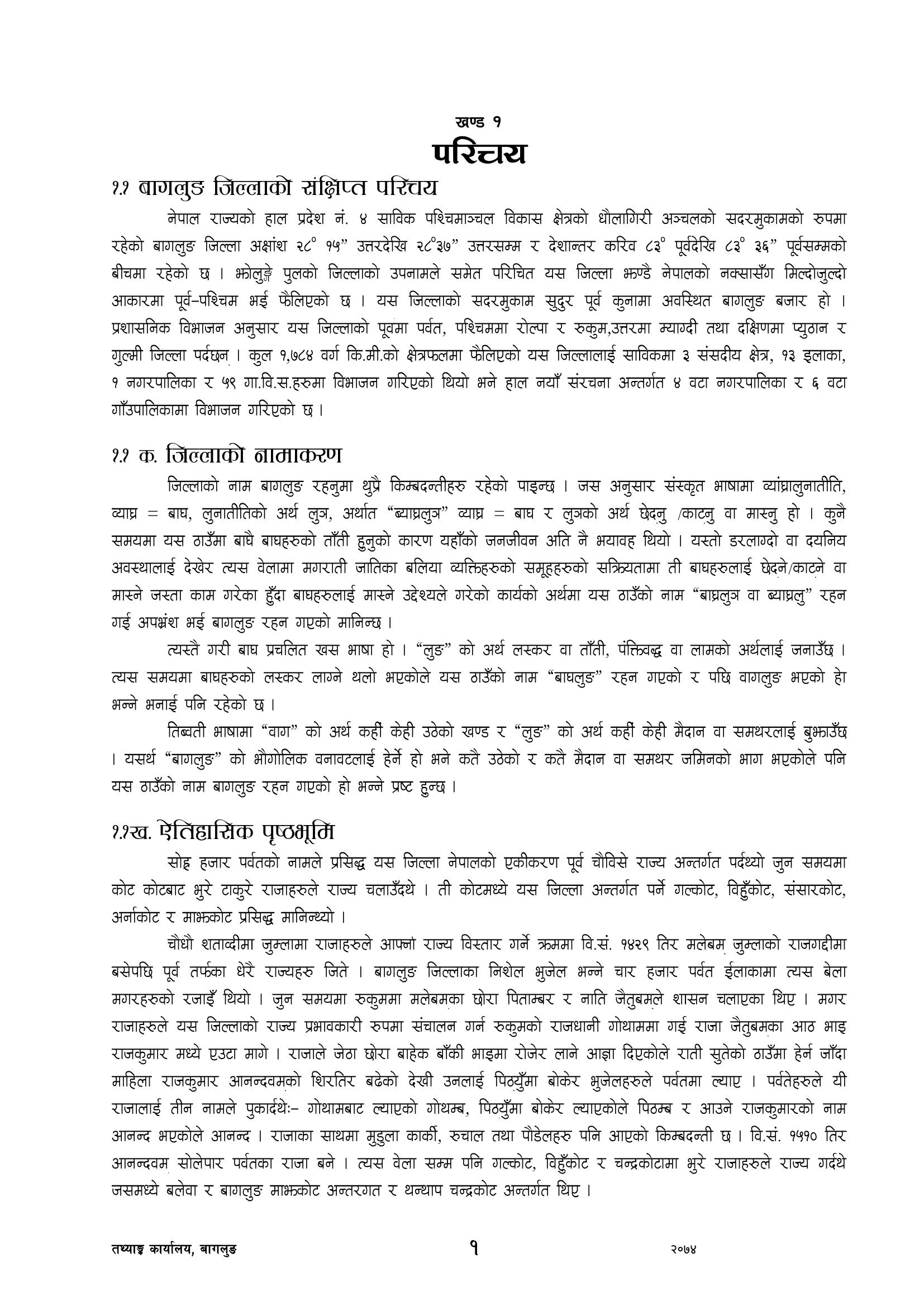
DISTRICT PROFILE - BAGLUNG
The " DISTRICT PROFILE - BAGLUNG " is published in NA None by Central Bureau of Statistics/National Statistics Office and can be found in the Publications of the Nepal in Data Portal. The information contained in this publication can be accessed via the Resource Menu of the Nepal in Data Portal by selecting the section State & Politics . This publication is in Nepali and is published in pdf format.

Submit your details below to receive Newsletters

- Nagarik Network
- Food & Drinks
- Heart To Heart
- Exhibitions
- 5 things about
- Rising Star
- Here's Why
- Browse here:
Kasaju is an Analyst and Singh is the Team Lead for the project on tourism at VRock& Company.
Baglung: Destination for adventure and religious tourism
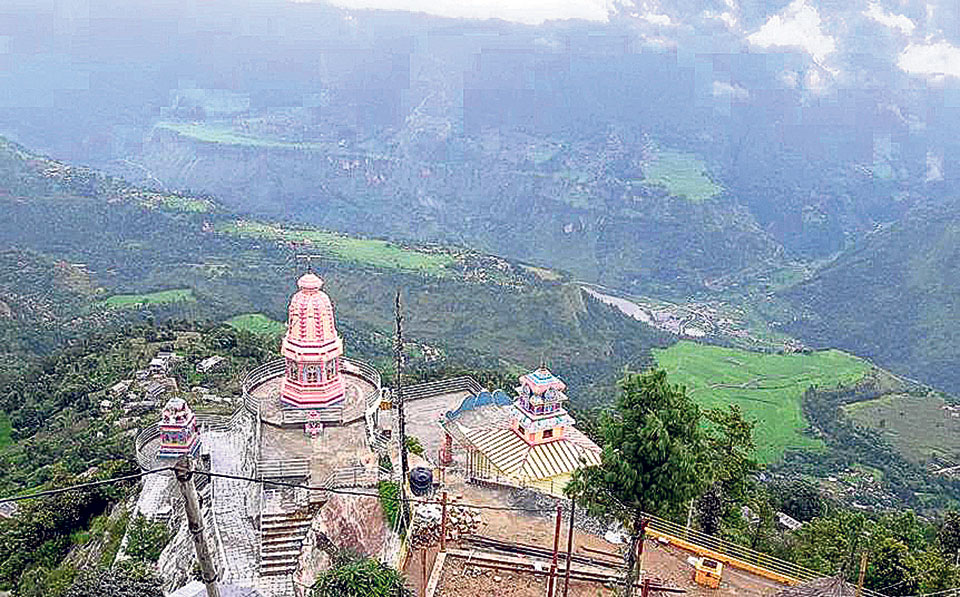
Tourism in Nepal is synonymous with Pokhara. However, this time it is not Pokhara, but Baglung that we are talking about. We had our eyes on Balewa, where the local airport had just come into operation after 28 years. We wanted to see for ourselves the untouched natural beauty and explore the hidden tourism treasure in Baglung and here’s what Baglung offered on a recent trip.
Panchkot Dham, Baglung Conventionally, the first stop was Pokhara. We arrived at the airport at around 8:15 am. The majestic Mt Machhapuchchhre stood in front of us as if it wanted to welcome us in Pokhara. The view was breathtaking. We gathered our bags and hit onto the Pokhara-Baglung highway. As we traveled, we passed through Sarangkot, which is famous for paragliding, ziplining, and its breathtaking views.
After the busy airport road, the Pokhara- Baglung highway nudges the hectic urban sprawl, and without realizing, the highway started becoming narrower. Seti River flowed next to us for half an hour until it diverted its route; Mt Machhapuchhre never left our view. We came across many temples along the road – every hill-top had a small temple giving the hill its own holy identity. After reaching Nayapul, we took a break for some delightful breakfast. Nayapul is a one-road town lined with shops catering to trekkers. This is also the beginning point of the famous Annapurna Circuit trek.
Baglung Bazaar Baglung Bazaar, the oldest and currently the largest settlement of Dhaulagiri Zone, is a 45-minute ride from Nayapul, which is the core area of the present Baglung municipality. We were surprised not to find any foreign tourists dwelling around the Baglung Bazaar. Perhaps there was not much to see, and the settlement seemed cramped. It seemed it had reached its saturation point. Unlike Pokhara, it is still not exposed to the global tourism economy. Up until now, the settlement of Baglung Bazaar had grown organically to meet the demands of the locals and for those who come for business purposes. The shocking fact is that even though the bazaar is unplanned, the land value is in par with Kathmandu’s. An hour-long drive from Baglung, there is a small village named Bhakunde – inhabited by the Magar community. It offers homestay and provides a cultural feel, especially to the domestic tourists.
Panchakot Dham The locals recommended us to visit Panchakot Dham. It is developing into a religious pilgrimage site which is situated on a hilltop – 13 km uphill from Baglung Bazaar. The place has a fascinating view of hills, ridges, and Dhaulagiri Mountain. There is a Kali Temple near Panchakot Dham, which complements and provides additional value to the entire set up. This site can be a catalyst to attract both Nepali and Indian pilgrims, especially those traveling to Muktinath.
Kalika Temple Another fascinating attraction of Baglung is the Kalika Temple. The temple has an amazing set up which provides a feeling of serenity and tranquility. It is located at a distance of 5.5 km from Baglung Bazaar. It is nestled deep inside a dense forest at the bank of the Kali Gandaki River. People flock in the temple with a hope to fulfill their desires and wishes. Even marriages are conducted inside the temple.
The belief goes that animal sacrifices in Kalika temple will lead to wished being fulfilled. With this faith, thousands of goats, buffaloes, ducks, and pigs are sacrificed. The temple, along with its cultural and historical importance, supports the socio-economic development of the local area as well.
Balewa Airport Though the Balewa Airport is in Baglung district, it is 19 km away from the town center and takes about an hour and a half to reach. The roads are still uncomfortable due to their poor quality. It does not have any road signs or milestones, which makes traveling difficult for first-time travelers. Additionally, the airport neither had any proper signposts, nor did it have a proper terminal building. It was apparent that the airport needed additional upgrades to ease the commute.
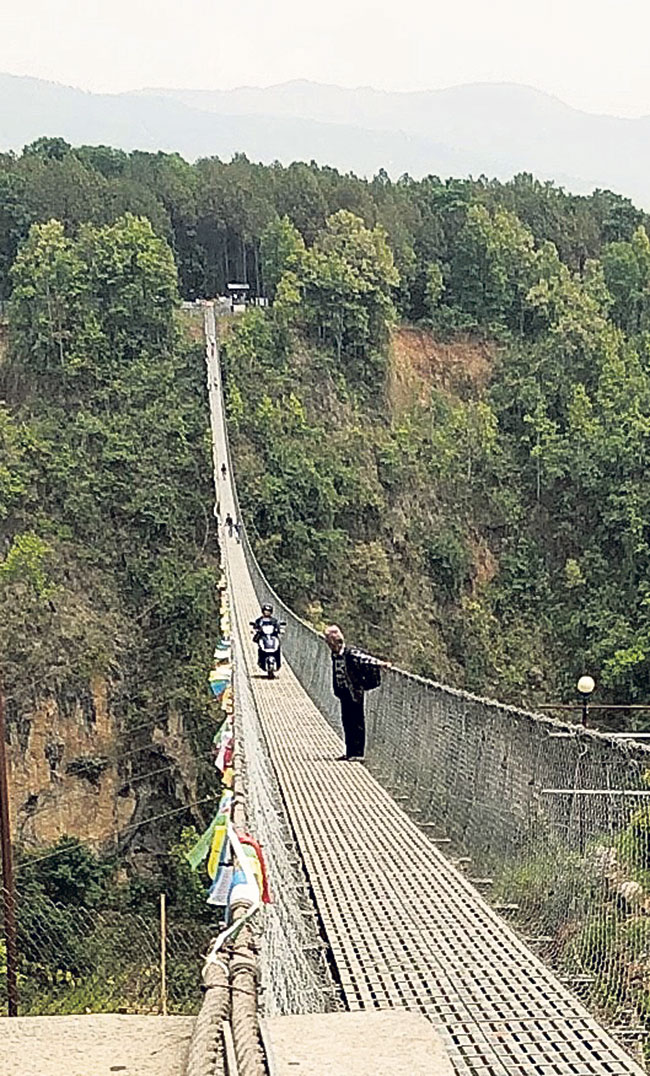
On our way back, we took a detour to the famous suspension bridge in Kushma. The bridge was thrilling to walk over; it was so high that the river beneath looked like a stream, and eagles were flying below it. We could see the possibility of adventure sports like bungee jumping from the bridge.
While returning from Baglung, we realized the depth of Robin Sharma's quote: “Change is hard at first, messy in the middle and gorgeous at the end.”
We felt, and experienced what he said – the memories are still intoxicating. The shaky and mysterious roads that led to the mesmerizing beauty of Baglung are now a part of the adventure we had. Baglung can undoubtedly be an enchanting tourist destination in the years to come.
tourism , nepal , baglung , adventure , religious ,
Share on Facebook
Share on Twitter
Leave A Comment
Panchakot: A Cultural And Tourist Destination
Panchakot has turned into one of the main tourist destinations of Baglung district after the establishment of Panchakot Ekikrit Basti in Ward-6 of Baglung Municipality.
NEW SPOTLIGHT ONLINE
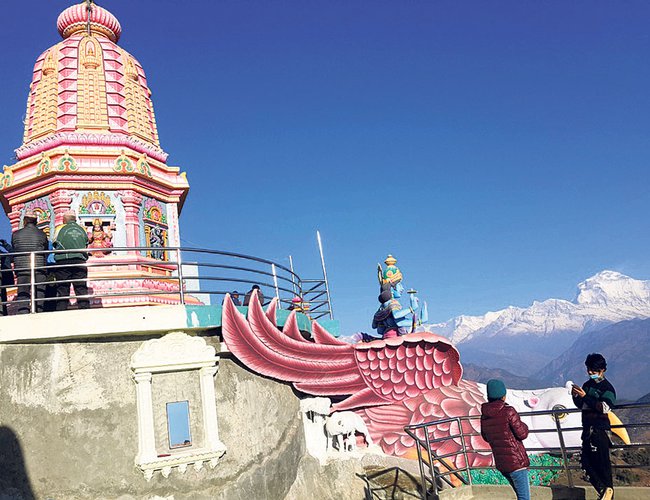
As some of the construction of infrastructure has been completed that was being built under the leadership of Muktinath Baba, a Hindu sage, the influx of tourists has increased in this area. His dream of changing his hometown into a pilgrimage site is now turning into a reality.
He said: “This is the only place in this entire world where we can find Shaligram stone. So this is a resident of all gods and I had planned to build a pilgrimage site in this area where people can worship all gods.”
People of this area are also supporting to fulfill the dream of the sage. First, this was just a dream of Muktinath Baba but as this is related to the development of Baglung, it has now become a dream of all Baglung residents.
“We have planned to develop a pilgrimage site of all gods and goddesses in this place so that people can worship different gods and goddesses at the same place,” said Muktinath Baba.
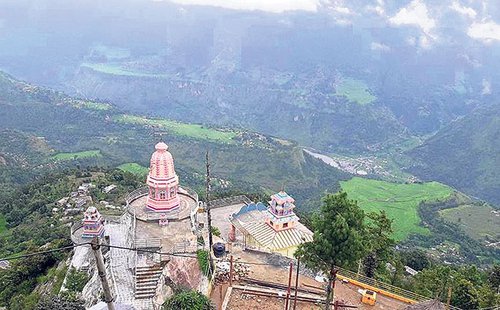
Panchakot is made by symbolically merging the names of five different places (kots): Tatajalkot, Karikot, Majhkot, Raynaraynakot, and Sansaarkot. These places are also related with the ancient kings. The kings established different religious places to worship divine energy and to get power from it.
According to Rishi Prapannacharya, the mulpurush (primordial man) of all communities of Nepal will be established in Panchakot. “We will develop this place into a common religious site by establishing all mulpurush of all communities at the same place, including those of adivasi, janajati and Arya communities, so that this place becomes a temple for all,” he said.
He said they are not planning to develop Panchakot into just a religious site. “All religious sites have their own importance. We want to develop Panchakot into a unique place in its own right. This place hast its own identity,” he added.
Infrastructure worth Rs 140 million has been constructed in Panchakot. The construction was started with the amount that was collected through a Maha Yagya (Vedic ritual) organized in 2014. A 108-feet-tall urn is being installed as the main attraction of Panchakot. Many new religious structures are under construction at the moment.
A 3-storey-tall building for guests, pavement, and a temple of Gandaki goddess are being constructed. Structure necessary to place a 5,555-kg bell, statue of lord Hanuman, Ganesh temple and so on are already done. "It will take more than two billion rupees to construct all the structures as per our plan," said former chairperson of Panchakot, Narendra Sharma.
Along with the development of other structures, a cow ranch is also being constructed in Ward 5 of Baglung Municipality and Jaljala Rural Municipality.
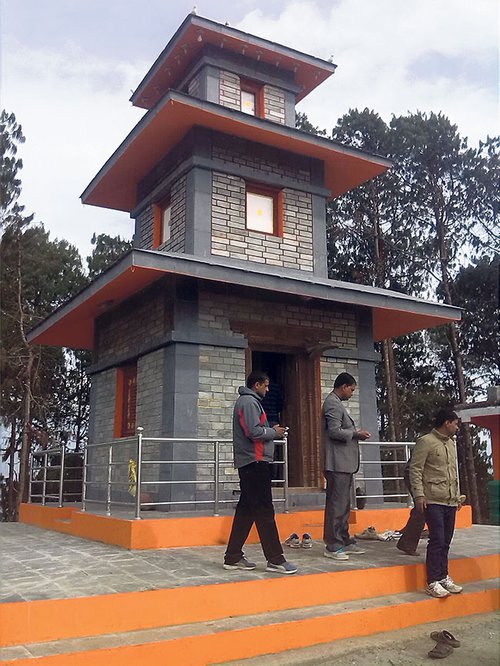
“Nowadays, the number of people visiting Panchakot has increased. Hundreds of people visit Panchakot daily,” said former secretary general of Panchakot, Basanta Kumar Shrestha, "Inflow of tourists in Panchakot is comparatively high in public holidays.” With the increase in the inflow of tourists, the condition of roads has been improved. All roads of Panchakot are black-topped.
Apart from the cultural and religious importance, Panchakot is also famous for a scenic view of mountains. Locals here are expecting an increase in economical activities through promotion of Panchakot as a tourist destination. "If we were able to hold those pilgrims who visit Muktinath Baba just for one night in Panchakot, the surrounding areas can also get benefited," said Jaya Ram Bhari, president of Baglung Chamber of Commerce and Industries.
Baglung Municipality has also vowed for the development of tourism in the place. The resumption of Balewa Airport comes as the starting point of the efforts.
"We are working for systematic development of this area for tourism. We are now focusing on areas such as Baglung Kalika, Bhairabsthan Bhakunde among others, and religious places are also being linked as tourist destinations," said Janakraj Poudel, mayor of the municipality.
Source: My Republica

More on News
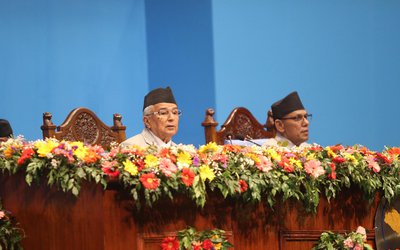
Latest Magazine
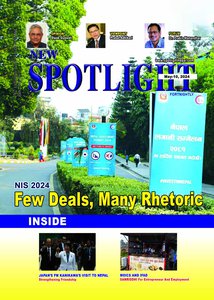
VOL. 17, No. 19, May.10,2024 (Baishak,28. 2081) Publisher and Editor: Keshab Prasad Poudel Online Register Number: DOI 584/074-75

VOL. 17, No. 18, April.26,2024 (Baishak,14. 2081) Publisher and Editor: Keshab Prasad Poudel Online Register Number: DOI 584/074-75

VOL. 17, No. 17, April.12,2024 (Chaitra,30. 2080) Publisher and Editor: Keshab Prasad Poudel Online Register Number: DOI 584/074-75

VOL. 17, No. 16, March.29,2024 (Chaitra,16. 2080) Publisher and Editor: Keshab Prasad Poudel Online Register Number: DOI 584/074-75

- Entertainment
- Nepali Typing
- Nepali Date Converter
- Nepali Calendar
- Preeti To Unicode
- Unicode To Preeti
5 Best Travel Destination in Baglung

The best part of the travel is to experience new places and cultures and immerse them into it. As Nepal, we are known to the world for our rich natural and cultural potentials. However, some parts of Nepal are still on the dark side of the world. So, in this article, we will explore the unexplored district of Nepal, Baglung .
Baglung lies in the western part of Nepal which takes about 275 km from Kathmandu. Baglung city is a major centre for people of mid-Kali Gandaki valley in terms of business, finance, education, and healthcare. This city is at the Kali Gandaki gorge directly south of Dhaulagiri Himalayan range. The climate variation range from hot subtropical to temperate monsoon climate because of large topographic variation. We have listed the hidden tourism treasure in Baglung which is still not so popular in the country.
1. Chitre High Bridge Trek

If you are willing to trek in the less crowded yet more beautiful part of Nepal then this trek will be suitable for you. Chitre high bridge trek is the life-changing experience and experiences the lifestyle of rural Nepalese life with untouched nature. This trek makes unique because it includes Chitre Trek and Panchase Trek. You will also see the iconic view of white dazzling mountains like Hiunchuli, Tukuche, Barha Shikhar, Lamjung Himal, and Dhaulagiri. Another best part of this trek is a homestay with local peoples and the breathtaking morning view of mountains from the view tower. Hence, you will experience the complete package of beautiful mountains, local peoples, daily lifestyle, and untouched nature in this trek.

2. Baglung City

Baglung city is a large settlement of Dhaulagiri Zone and the oldest too. Baglung city is about 45 minutes drive from Nayapul. Baglung city is beautiful but it is not so popular and you cannot see many tourists here. The extension from Baglung city is Bhakunde village. This small village is located 1-hour drive from Baglung. This village is of the Magar community and offers homestay which allows you to fell the culture of them from close.
3. Panchakot Dham

Till now Panchakot Dham is only known to Baglung are after the establishment of Panchakot Ekikrit Basti. According to Muktinath Baba, this is the only place that we can find Shaligram stone. This Dham is made by merging the name of five different kot: Karikot, Raynaranynakot, Tatajalkot, Sansaarkot, and Majhkot. This Dham can be reached by 30 min bus ride from the Baglug Bazaar5. . According to the head of this temple, he wants to develop Panchakot into a unique place establishing all primordial of all communities including Adivasi, Janajati, and Aryan community. This place will not only be a religious place for one community but the entire community.
4. Kalika Temple

Kalika Temple is another fascinating attraction in Baglung city. Visiting this temple will amaze you with serenity and tranquillity. This temple is established approximately 6 km far from Baglung Bazaar. this temple is located in the bank of Kali Gandaki River inside dense forest. Some people perform ritual like marriage in this temple. People believes that scarifying the animal and worshipping the Kalika god leads to wish become fulfilled. With his faith, many people sacrifice goats, ducks, buffalo and pigs in this temple.
5. Shivadhuri Village

The beautiful small village named Shivadhuri is located in Nepal’s Baglung district. This village is all set to welcome domestic as well as international tourist. This village just introduced a Homestay facility to flow the tourist. According to Shivadhuri Community Homestay, they have a capacity of 70 beds in 12 homes. This village is sitting at an altitude of 1800 meters and also famous for rhododendron and magnificent view of Annapurna.
Related Topic: Travel Guide: Tindhare Jharana |Bahubali Falls| Kavre, Nepal

Quick Links
- Date Converter
- Content Guidelines
- Privacy Policy
ONLINE MAGAZINE
- Information
Social login

Recent Posts
- Amazing facts about Nepal
- Worshipping Self in Mha Puja
- Hotel Glacier Pokhara
- Culturally rich Rajbiraj
- The temple of Indresvar Mahadev
- Business Ganesh temple
- Sunil Pokharel, Nepali theatre guru
- Mohan Sundar Shrestha, playing and surviving on Sarod
- Protected Biodiversity in Nepal
- The Gurkha’s Daughter by Prajwal Parajuly
Baglung Kalika Temple
Situated in the Baglung district in far western region in Nepal, the temple of Baglung Kali Bhagawati is one of the famous temples in Nepal. Also known as Kalika Bhagawati temple, it is one of the most religiously significant places located deep inside the dense forest just above the northern side of Kali Gandaki .
Kali is one of the most powerful and dangerous form of the Hindu goddess Durga and is often associated with the power, Shakti . Goddess Kali also means ‘the black one’. She is considered Kali, consort of Lord Shiva which also means time or death as Lord Shiva is often considered as ‘ Kala ‘, the eternal time. She is the prime goddess of the Dasa Mahavidyas, ten fierce goddesses of Tantra or the Tantric goddesses. Besides this, Kali is strongly associated with Shiva and Shaivas derive the masculine Kala (a form of Shiva ) from her feminine name.
It is said that the goddess fulfills the wishes of the devotees if they could please her. She is also known as Bhavatarini literally meaning ‘rescuer of the universe’.
Popular Today
Phortse Ecotourism Village, Khumbu
The festival of Matya in Patan
Best Schools in Kathmandu 2017 (2074)
Making masaura
Manjushree Thapa, prominent Nepali writer
Rice Dhakani
- cities/villages
- World heritage sites
- Mountaineering& ADVENTURE
- Culture Watch
- Useful Info/Tips

Baglung attracting domestic tourists

Mountain ranges and beautiful human settlements are common scenes that is attracting domestic tourists in Baglung. Some tourist destinations in the district like Jaidi, Chhisti, Handikot and Kaudeko Dhuri have lured domestic tourists lately. Local levels have joined hands to make publicity and conserve the natural beauty of the district.
Local journalists and youths associated with ‘Ghumante Group’, a group dedicated to tourism promotion, reached Jaidi, Chhisti and Handikot in Jaimini Municipality in a bid to create awareness on tourism. Watching sunrise up from the hills gives bliss to the nature lovers.
Golden rays of the sun in the morning hitting mountains attracted the domestic tourists, said journalist, Sajjan Kumar Singh, a member of the visiting team.
Handikot, which has huge potential for tourism, has been under the shadow for want of its conservation, he said. Situated 2,195 meters from sea level, one can view mountain ranges, sunrise and sunset and terrains as far as Palpa and Butwal from Handikot.

Medicinal herbs, forest products and habitats for rare birds and animals are other features of the area. Handikot lags behind in terms of development for lack of tourism infrastructures and publicity, said local people.
Efforts are underway to connect to Handikot through roads and trails. Investments were being poured in and a mega plan has been devised for the development of Handikot, said Deputy Mayor of Jaimini municipality, Lila Rana.
“The village is a base for the economic prosperity of the municipality,” she said. Kaudeko Dhuri lying at the borders of Bareng in Baglung district and Kaligandaki and Chandrakot Rural Municipalities in Gulmi district is another tourist destination.
One can see mountain ranges, sunrise and sunset from the area which is situated 2,100 meters from above the sea level. One can view terrains of Parbat, Syangja, Pokhara, Palpa , Butwal and Argakhanchi from the area.
Home to rare birds and animals, Kaudeko Lake situated 2,600 meters above sea level has been under shadow due to lack of tourism infrastructure and publicity, said local people (RSS).
RELATED ARTICLES
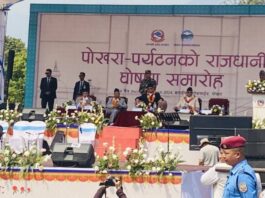
Pokhara declared as Tourism Capital of Nepal

Nepalgunj-Janakpur direct flight begun

Pokhara to host silver jubilee of street festival
No comments, leave a reply cancel reply.
Save my name, email, and website in this browser for the next time I comment.
You are using an outdated browser. Please upgrade your browser to improve your experience.

Baglung Kalika Bhagwati Temple
Longitude: 82°52’47’’-83°40’38’’ Latitude: 28°04’38’’-28°38’06’’
Maximum: 21.°c Minimum: 5°c
Sub-tropical, Temperate, Sub-Alpine
Hotel, Lodge, Resort and Community Home Stay
Dance-Lakhe, Maruni, Ghatu, Hanuman, Jogi, Ropai, Katuwal, Putali, Ghantakarna, Sisno, Khesnae, Bagh (Tiger), Mayur (peacock), Jhakri, Adi, Sorathi, Salejo, Kheli, Thado Bhaka, Cultural and religious fairs
Pokhara to Jomsom: 72 km by Bus
Hospital, Health Post, Ayurvedic Centers, Clinic
Situated inside a forest about 2km away from Baglung Bazar, the temple as a monument holds historical and religious significance. Built around 1534 by king Mani Mukunda Sen of Palpa, the temple was said to have been built by the king on the wishes of his daughter Bishrawa Sen after her marriage. There is a throng of people each Tuesday and Saturday and on Ashtami of the full moon calendar during the month of April.
Every year, the Chaite Dashal fair is organized in this temple area and a huge number of people visit this temple. This temple has been enlisted in the top 100 tourism destinations of Nepal by the Nepal government.
Latest Articles
Lorem ipsum dolor sit amet, consectetuer adipiscing elit, sed diam consectetuer

Pokhara officially declared as Tourism Capital of Nepal

44th World Tourism Day
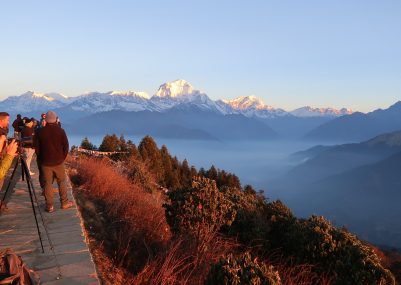
Poon Hill Yoga Trek In Gandaki
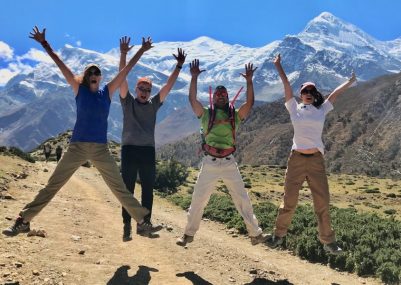
Annapurna Circuit Among 10 Must-Visit Destinations On Lonely Planet

IMAGES
VIDEO
COMMENTS
The headquarters of Baglung District is Baglung Municipality which is located on a plateau overlooking the holy Kali Gandaki. Like Nepal, Baglung is also diverse in religion, culture, ethnicity, altitude, temperature etc. Hinduism and Buddhism are the major religions. ... Literacy: 80.1% could read and write, 2.6% could only read and 25.7% ...
Bhakunde is a small village in the Baglung district of Nepal, located about 10 kilometers from the city of Baglung. Bhakunde is home to the Magar community, one of Nepal's many ethnic groups, and is known for its rich culture and stunning natural scenery. The village is on the hilltop overlooking the Kali Gandaki River gorge.
Baglung District - District in Gandaki Province. Baglung District is one of Nepal's seventy-seven districts and is located in Gandaki Province. The district, which has Baglung as its district headquarters, has a population of 268,613 people and occupies an area of 1,784 km2 (689 sq mi). Today we talk about different aspects of Baglung.
Baglung is a Municipality in Gandaki Province that lies in Western Nepal which is 275 km far away from Kathmandu. It is the headquarters of the Baglung
Baglung Bazar. Baglung is a municipality in Gandaki Province, in western Nepal, 275 km (171 mi) west of Kathmandu.It is the administrative headquarters of Baglung District.Baglung serves as the major center for business, finance, education, service and healthcare for the people of mid-Kali Gandaki valley that encompass Beni, Jaljala, Baglung, Kushma, Kathekhola, Galkot, Phalewas and Jaimuni ...
Baglung is a Municipality, which is located in Baglung district, Gandaki Province of Nepal. Baglung has total 14 wards, which are scattered across 98 square kilometers of geographical area. ... There were only 41,777 people fully literate in Baglung Municipality as of 2011 who were able to both read and write, while 909 people were able to read ...
After establishment of the current district and zonal system, Baglung retained its status as headquarters serving the area. Several irrigation channels, pastures, watering holes, fruit gardens are established in Baglung Municipality. The total area of the Baglung Municipality is 98.01 km2 (37.84 sq. m)
Brief Introduction. Baglung District, a part of Dhawalagiri Zone, is one of the seventy-five districts of Nepal, a landlocked country of South Asia. The district, with Baglung as its district headquarters, covers an area of 1,784 km² and has a population (2011) of 268,613. Baglung is surrounded by Parvat, Myagdi, Rukum, Ropla, Pyuthan and ...
About Baglung. Baglung is surrounded by Parbat, Myagdi, Rukum, Rolpa, Pyuthan and Gulmi districts. The district consists of 11 Municipalities, out of which four are urban municipalities and six are rural municipalities. These are as follows. Baglung Municipality (the district's headquarter) Dhorpatan Municipality. Galkot Municipality.
Baglung: Politics and Migration. May 3, 2013. Thirty-five years ago, the plateau now occupied by Baglung Bazar was a quiet plain of rice fields with a dozen or so two story mud brick houses, a brand new college campus and a tiny hospital. Twenty-five years ago, a formal water infrastructure was introduced by an International NGO.
Baglung, located in the western part of country, resembles like Nepal in country map. Geographically it stretches east-west. It is 72 km drive west from the country's tourist city Pokhara. Popularly known as a district of suspension bridges, it features many other unique and important natural and cultural aspects.
Time zone. UTC+05:45 ( NPT) Website. Official Website. Baglung District ( Nepali: बागलुङ जिल्ला Listen (help·info)) is a district in Nepal. It is in the Gandaki Province. The district headquarters is Baglung. The district covers an area of 1,784 square kilometres (689 square miles). In 2011, it had a population of 268,613.
Situated on the plateau overlooking the beautiful Kali Gandaki gorge and placed directly to the south of the Dhaulagiri Himalayan Range, Baglung city is a place no one should miss out on exploring. Baglung is the municipality. Baglung Bazaar is connected to Beni Bazar of Myagdi to the north and Kushma Bazar of Parbat which are located 13 km to the north and 12 km to the
Baglung bazar, the town is well connected with Myagdi's Beni bazar and Parbat's Kushma bazar. Baglung bazar is 272km west of Kathmandu, 13km south of Beni bazar and 12km north of Kushma and it is 72km west of Pokhara. Although there are currently no air links to the district, there is an airstrip in the district in Balewa.
Baglung is a road less traveled offering the travelers with an array of natural, cultural, and recreational activities. Baglung district is a part of Gandaki Province of Nepal. Known to be a business hub for northern and southern part of Nepal, Baglung now serves as a transit center for those visiting the Annapurna , Dhaulagiri , Dhorpatan and ...
DISTRICT PROFILE - BAGLUNG June 10, 2020. The "DISTRICT PROFILE - BAGLUNG" is published in NA None by Central Bureau of Statistics/National Statistics Office and can be found in the Publications of the Nepal in Data Portal.The information contained in this publication can be accessed via the Resource Menu of the Nepal in Data Portal by selecting the section State & Politics .
Baglung Bazaar Baglung Bazaar, the oldest and currently the largest settlement of Dhaulagiri Zone, is a 45-minute ride from Nayapul, which is the core area of the present Baglung municipality. We were surprised not to find any foreign tourists dwelling around the Baglung Bazaar. Perhaps there was not much to see, and the settlement seemed cramped.
Brief Introduction. Baglung District, a part of Dhawalagiri Zone, is one of the seventy-five districts of Nepal, a landlocked country of South Asia. The district, with Baglung as its district headquarters, covers an area of 1,784 km² and has a population (2011) of 268,613. Baglung is surrounded by Parvat, Myagdi, Rukum, Ropla, Pyuthan and ...
April 24, 2018, 12:46 p.m. Panchakot has turned into one of the main tourist destinations of Baglung district after the establishment of Panchakot Ekikrit Basti in Ward-6 of Baglung Municipality. As some of the construction of infrastructure has been completed that was being built under the leadership of Muktinath Baba, a Hindu sage, the influx ...
With his faith, many people sacrifice goats, ducks, buffalo and pigs in this temple. 5. Shivadhuri Village. The beautiful small village named Shivadhuri is located in Nepal's Baglung district. This village is all set to welcome domestic as well as international tourist. This village just introduced a Homestay facility to flow the tourist.
Situated in the Baglung district in far western region in Nepal, the temple of Baglung Kali Bhagawati is one of the famous temples in Nepal. Also known as Kalika Bhagawati temple, it is one of the most religiously significant places located deep inside the dense forest just above the northern side of Kali Gandaki.. Kali is one of the most powerful and dangerous form of the Hindu goddess Durga ...
Mountain ranges and beautiful human settlements are common scenes that is attracting domestic tourists in Baglung. Some tourist destinations in the district like Jaidi, Chhisti, Handikot and Kaudeko Dhuri have lured domestic tourists lately. Local levels have joined hands to make publicity and conserve the natural beauty of the district.
Baglung Kalika Bhagwati Temple. Situated inside a forest about 2km away from Baglung Bazar, the temple as a monument holds historical and religious significance. Built around 1534 by king Mani Mukunda Sen of Palpa, the temple was said to have been built by the king on the wishes of his daughter Bishrawa Sen after her marriage. There is a throng ...